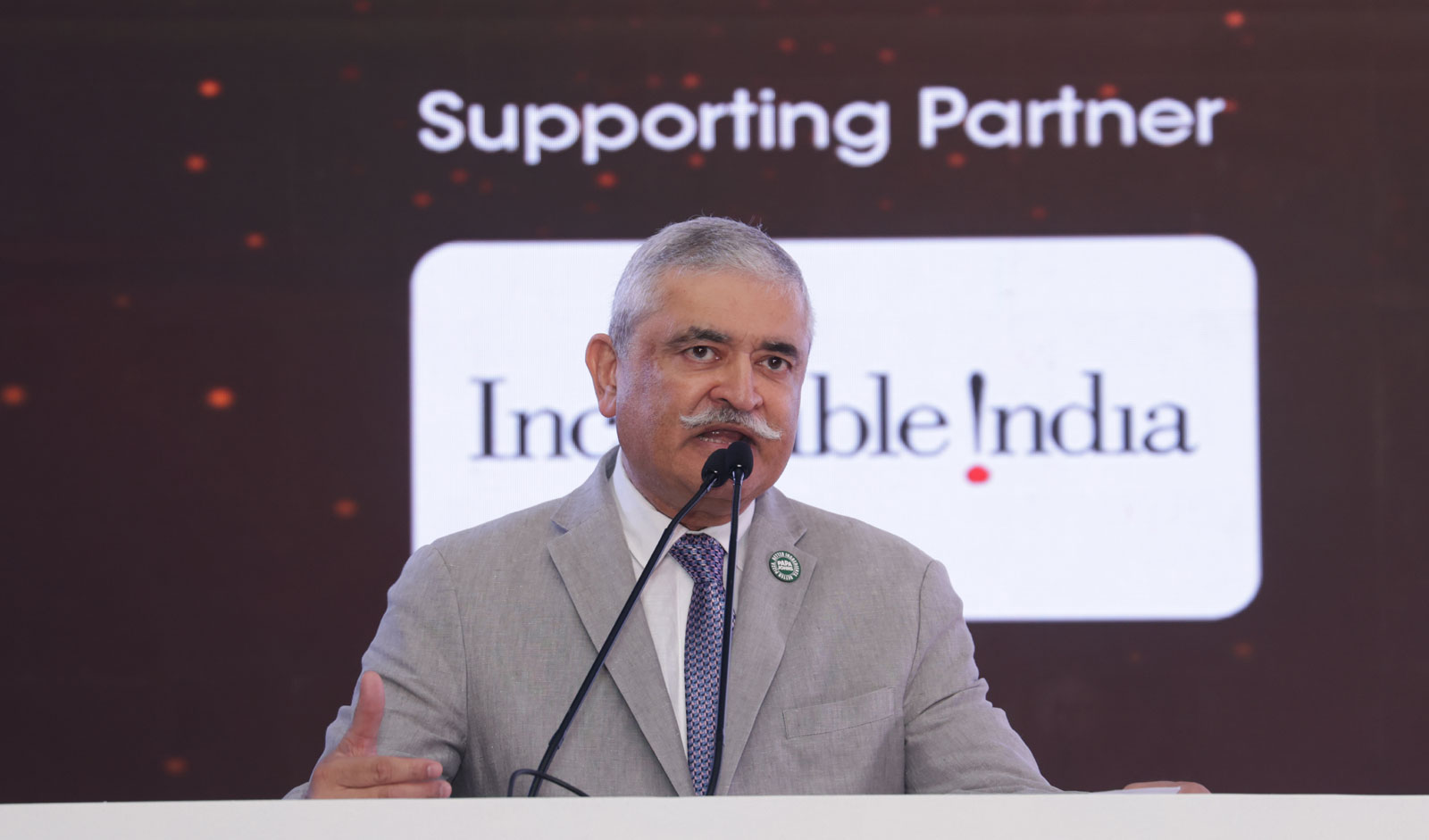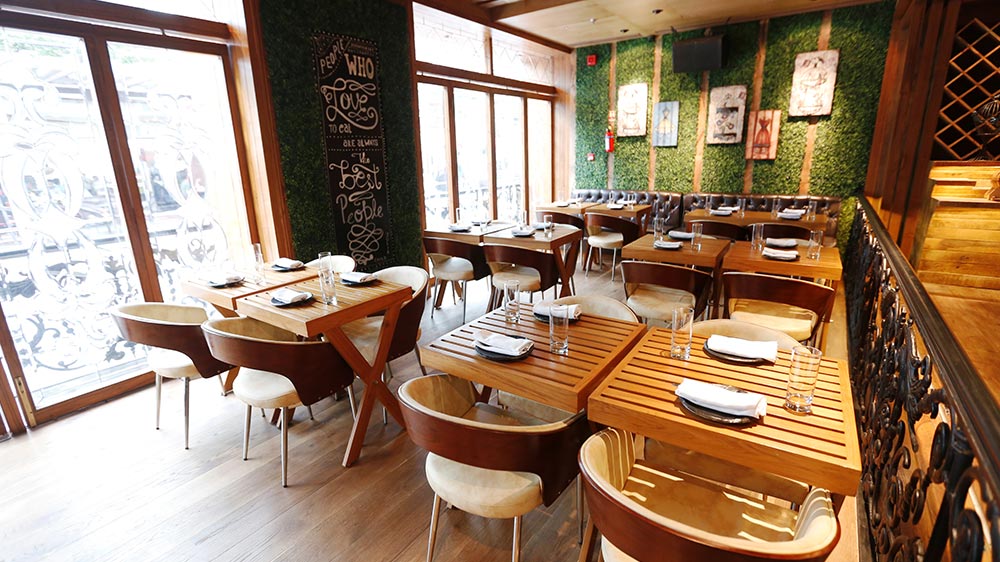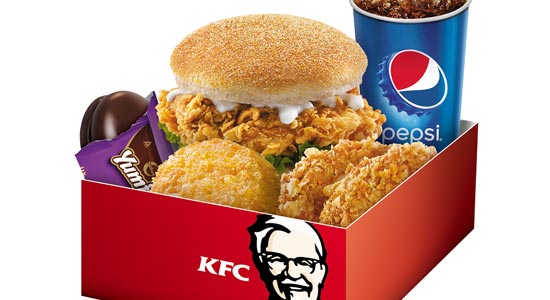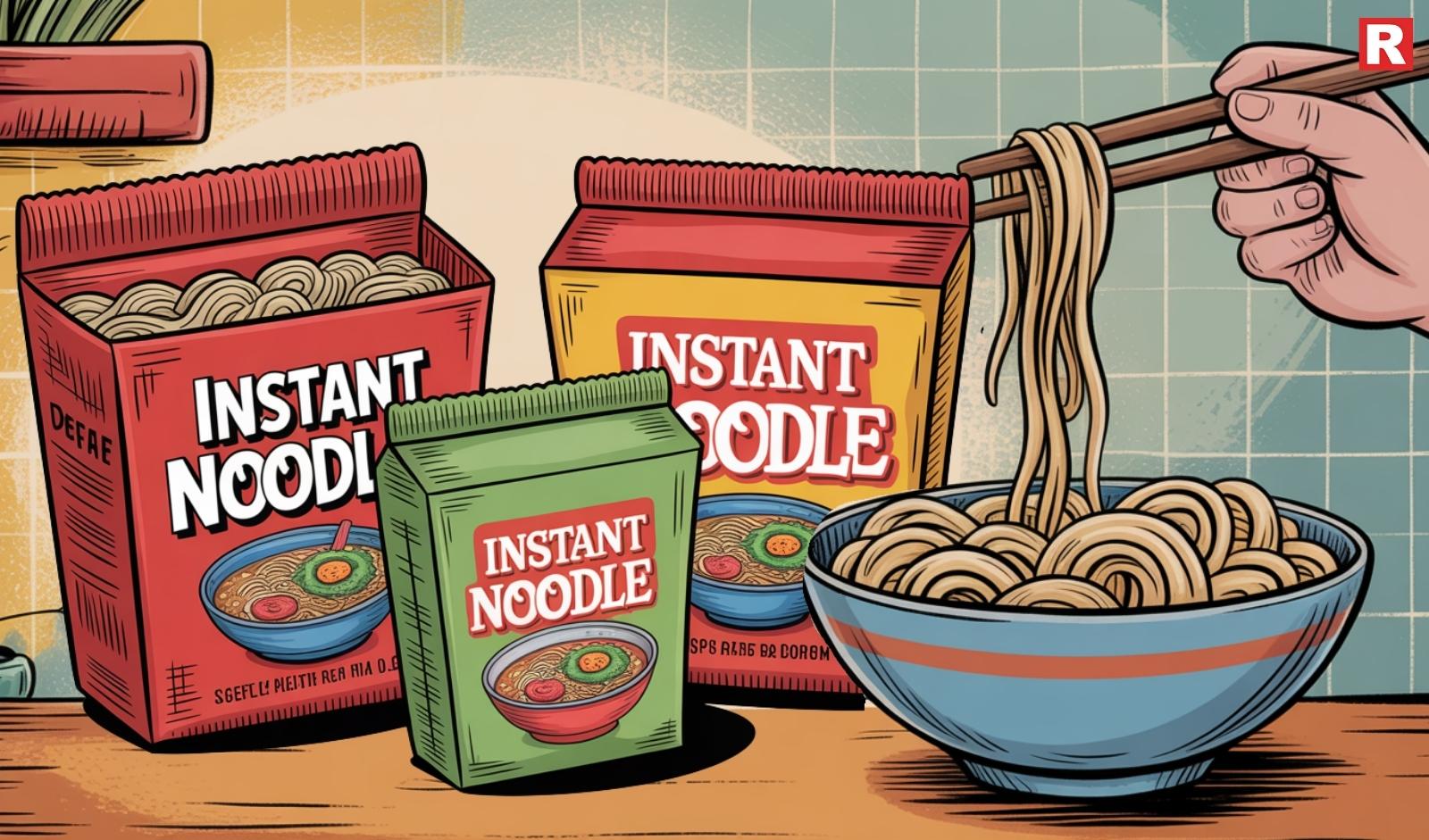
Bringing foreign brands is very aspirational for Indian entrepreneurs. We have seen success of few foreign brands in F&B especially players like Domino’s, McDonald’s to name a few and there is footprint present of many outlets like KFC, Pizza Hut. So, Indian entrepreneurs feel that the foreign brands do well in India.
Foreign brands are very inspirational for the end consumer, making it a major reason for entrepreneurs to tie-up with foreign brands. Inorder to get initial traction and good marketing there is always goodwill and fan base established of that brand. There are lots of challenges that come when you tie-up with a foreign brand. However, there are a few points that an entrepreneur should take care of before bringing a foreign brand.
The right commercial deal: Foreign brands look at India as a country of 1.5 billion populations. Based on this when compared with USA, India has 3 times more population and a much larger population in comparison to UAE. Hence the business potential is that much more. Foreign brands fail to understand that the actual target clientele that’ll spend such amount of money is much lesser than the total population of 1.5 billion. Hence to understand what kind of brand an entrepreneur is getting and what will be their potential of growth across India, there should be a very well laid out commercial plan put up.
Study Competition: It is very important to study the local competition of the product that is being brought from abroad. Foreign brands have their own standards and norms because of which they are limited to change or tweak their menu & pricing strategy in a certain way. This leaves them with a very tough competition and the foreign brand ends up becoming just another brand in the market. It’s very important to be very cognizant about the current competition and the competition that can arise even if you are introducing the product in the market for the first time. Ignoring the competition that is present today and most importantly that can come in the future in the product category that you are signing off can be very fatal and dangerous because we are committing to foreign brands for a perpetual or a long-term agreement of 10-20 years and it’s very important to sustain in the markets for that duration to get good returns.
Localisation of brand: Localisation of any brand is very important not only for the brand identity and brand communication but also mainly by the localization of the menu. The common Indian palette is not used to experiment and even if it experiments it takes a long time to adapt to a new taste. Hence it’s important to localize the menu as per Indian standards.
Localising vendor sourcing for projects and interiors: We have seen a lot of international brands that insist on buying the project materials like furniture, kitchen equipments etc from their principal market. Also, we see a lot of brands insisting on buying basic raw material from the principal market. However, they ignore the high import cost, logistics, and excise which sums up to a higher project cost or capital investment or higher recurring food cost which leads the Indian partner to increase the menu price. Thereby, making them non-competitive.
Customise standard operating processes, training modules and software: All the countries have standard operating processes, training modules and software, suiting the requirement and the operations of their own country. It is very important to study the ground realities of each country and region and customize the SOP’s, training modules and software as per the skill & requirement in that particular region. Only when the entire eco-system revolves around the requirement of the region and it is customized to those requirements there will be better results of the intellectual property that can be leveraged in India.
Identify the strength of brand and deciding the roles and responsibility: It is very important to identify brand stands for if the brand is standing for a particular product or addressing to a particular demography and its current stores operating in current countries has to be very clearly identified and the strategy around India has to be made accordingly.
Plan B: It is very important for a brand to have a fall-back plan. This does not mean that there will be compromise in the quality of the products served but it is always important to work out the kind of menu & pricing that the local partners will be offering if first strategy fails. India is a very unpredictable market and it is very important to be on your toes to understand customer demands and make an overnight change to be able to cater to those demands. Of course, keeping in mind the strength & identity of the brand.
Strategy of growth (rollout plan and city wise plan): One needs to really define the rollout plan of any new brand. It’s important to study the demography and current customer requirements of cities in India and the product offering and the current TG of the brand in the country that it exists and then draw out good synergies and then draw out a very good strategic roll out plan.
Leverage partnerships/collaborations: It is very important for a potential Indian entrepreneur to understand who are the key partners and collaborators of the international brand that they are aiming to tie-up with.

The relationship between Dubai and India, particularly in the F&B sector, is blossoming. The UAE's strategic interest in food security coupled with India's agricultural prowess and burgeoning consumer market has created a dynamic corridor for growth.
The UAE-India food security corridor with significant investments in food parks and logistics is a testament to this partnership. This isn't just about trade. It's about building resilient supply chains and fostering a symbiotic ecosystem.
“For Papa John's, this translates into streamlined sourcing, efficient distribution, and a robust framework for expansion. Now, Dubai as a global hub offers a diverse F&B landscape and exposure to international best practises. India, on the other hand, with its vast and varied consumer base, presents an unparalleled market,” said Tapan Vaidya, Group CEO, PJP Investments Group (UAE, KSA & Jordan) & Treasurer & Executive Board Member at UAERG.
The corridor facilitates the exchange of culinary trends, operational expertise, and market intelligence, allowing brands to adapt and thrive in both regions as there's a strong cultural bond.
“The shared appreciation for good food, hospitality, and entrepreneurial spirit makes this corridor a fertile ground for F&B ventures. Our success in the UAE, KSA, and Jordan, serving a significant Indian diaspora, gives us a unique understanding of Indian consumer preferences, which is invaluable as we expand here in India. Now, building partnerships,” added Vaidya.
How to grow your business via collaboration
“Collaboration is the bedrock of successful cross-border expansion. For Papa John's in India, our JV with Pulsar Capital, in which we are one of the longest standing international franchisees of Papa John's, and Pulsar understands local intricacies in India, is a prime example,” shared Mr. Vaidya.
Leveraging local expertise, entering a new market, especially one as diverse as India, requires deep local knowledge. And, for that a strong partner brings insights into regional tastes, regulatory frameworks, supply chain intricacies, and real estate opportunities.
“PJP's proven track record in the Middle East provides the perfect background for our India launch along with Pulsar's on-ground support,” he added as he plans to open 650 new Papa John's restaurants in India by 2033.
Delivery is the new game
The F&B landscape in India is dynamic, driven by a young, tech-savvy, and increasingly discerning consumer base. Understanding these shifts is crucial for innovation and sustained profitability, convenience and delivery dominance. The rise of online food delivery platforms and the demand for quick, convenient meals has transformed the industry.
“Papa John's, as a pizza delivery leader, is well positioned to capitalise on this. Our focus will be on seamless digital ordering experiences and efficient delivery networks. Health and wellness consciousness,” pointed Vaidya by adding that it is not just about bringing a global brand to India. It's about building a robust, locally attuned presence. Shifting consumer preferences, shaping restaurants, and franchise innovation.
Franchising is the key
A true franchising partnership goes beyond contracts—it’s about shared vision, aligned goals, and mutual growth. It’s not just a franchisor–franchisee relationship, but a collaboration built on co-creating value.
Such partnerships unlock operational efficiencies, whether through consolidated sourcing, shared marketing initiatives, or collaborative training programmes.
Franchises need to innovate to offer both the convenience of quick service and the allure of a memorable experience. Value for money and local relevance. In a price-sensitive market like India, offering value without compromising quality is key.
“Adapting menus to local palates and incorporating regional flavours while maintaining global brand standards is a delicate but crucial balance. Our strategy in India will involve a careful blend of our global bestsellers and localised offerings. Technology integration from artificial intelligence-powered recommendations to data-driven marketing and efficient back-of-house operations,” added Mr. Vaidya for whom technology is no longer an option but a necessity. And, Franchisors and franchisees must embrace digital transformation to optimise operations, enhance customer engagement, and drive growth. Next, make more money.
And, hence, there’s no denying that franchising is the easy way to own a business. Franchising offers a compelling pathway to entrepreneurship, particularly in the F&B sector, by mitigating many of the risks associated with starting a business from scratch.
I am incredibly optimistic about the future for Papa John's in India and the role this dynamic corridor will play in shaping the next chapter of our culinary success.

Convenient food options like pizza is becoming more and more popular due to rapid urbanization and rising disposable income. To broaden their market reach and boost overall profitability, pizza chains are concentrating on aggressive marketing strategies, such as celebrity endorsements and social media platform ads. In order to appeal to the varied Indian palate and draw in more customers, pizza businesses are always changing their menus and adding regional flavors and ingredients.
Over the last five years, India's pizza market has experienced remarkable expansion, with an annual growth rate of 26%. From 2024 to 2032, the market is anticipated to expand at a compound annual growth rate (CAGR) of 9.63%.
Jae Won Lim, Founder & CEO, GOPIZZA Global in a keynote session at Indian Restaurant Congress that happened in Delhi on 8-9th October explained about their brand and the ‘Global Perceptions that Drive Growth’.
Here are the key insights from his informative session:
Running on Popularity
“We are a South-Korean pizza brand. When we started GOPIZZA in 2016, I wanted to make a true QSR version of pizza; our motive was smaller size, faster servicing speed and cheaper price. We made these happen in the last 8 years. Pizza is considered to be a premium food and family diner by the rest of the world. It usually takes long to deliver,” shared Lim who has witnessed a dramatic change for the brand, starting from streets to India and to the President’s office in Korea. “Anywhere people want pizza, we give them pizza. Currently, we operate in 7 different countries and 1200 stores and we are serving more than 600 thousand customers every month globally,” he added.
Service at the Top
To build a restaurant is an art. The nature of this business lacks scalability and hence we need to continuously focus and grow it. We serve personal size pizza mostly and the price in India starts from 89 rupees. We normally serve our customers within 5 to 7 minutes and that’s where we are trying to compete with our peers.
Globalisation is the Key
Emphasizing on why to be a global brand, he added, MCD’s is the largest Fnb Corporation in the world. And, it is still growing like a teenager and has become a global brand, targeting the right market, clientele at the right time.
Today, many Asian countries where the market is stagnant and not going anywhere so the brands try to get out of their nation to see potential in order to grow more. In India, lots of markets are drooling over. Even if we have enough capital to build the brand, maintaining the brand name is a challenge as you need to achieve scalability and consistency at the same time.
“Profitability also plays an important role. One may have 100 stores that make money but you can’t predict if that money will be from the first 100 stores or not,” he mentioned as he aims at making GOPIZZA a global chain.
Scalability is Important
Running a restaurant is a difficult task. “We were funded 40-50 million dollars. We are the most valuable food tech company in South Korea right now. In order to prove to our investors, we have to prove all of them that we are scalable,” he added as he is targeting to grow his outlets and is keen on expanding to newer regions.
He also mentioned that he worked at a Pizza chain to learn how the brand can be scalable, consistent and profitable.
Infusing Tech for Efficiency
Elaborating further, he added, “Everyone has different skill sets in the restaurant, consistency can break and profitability isn’t guaranteed always. In order to achieve things, we took in food technology and came up with the concept of pre-make the dough. And, this was our mission, serve the food faster with the pre-make dough. Within a year of practice and research in kitchen, we started our truck. Within the truck, we were selling 800 pizzas per night. It was a huge success pizza food truck model for us. There were 12 people working in the truck, especially if you see the oven it’s very difficult to operate with more people around. The brand aims to become MCD of pizza by building accessible pizzas worldwide.
Use of Automation
“We thought why not make an oven with automatic rotator which can rotate the pizza without any manual help. Food technology was very important for GOPIZZA from the very early days. The brand uses cutting-edge AI technology, including the patented GOVEN, which bakes six pizzas in 3 minutes. We incorporated AI in to our kitchen in 2019; this is called AI Smart Topping Table. The AI Smart Topping Table monitors pizza toppings in real-time for precise results. In Korea and Singapore and in other places, there are literally no humans to work in restaurants and robots are doing the work. We are dependent of technology as it is evolving. We made tremendous growth in India serving around 100 thousand customers per month. The brand has expansion plans in India and in other locations,” he concluded.

Co-Founder, The Studs Sports Bar & Grill Apr 12, 2023 / 8 MIN READ
The market for Bars across the globe is ever-expanding. Taking a Bar franchise is one of the safest routes for starting an entrepreneurial journey in the Bar business. A franchise system gives enormous experience and expertise in every single part of owning the Bar business. This helps a Franchise Owner take safer routes of owning a Bar business wherein each step of the business is verified, tried, and tested and has a validation of success which the Brand gives the Franchise entrepreneur, who would otherwise be susceptible to errors in the business. Thus, the success rate of Franchisee businesses in India has always been much higher than that of standalone bars and restaurants.
The Studs, India’s Most successful Sports Bar Brand and one of the most profitable, and well-supported Franchise outlets networks - having a presence in over 7 states in India and Outlet presence across 15 locations – operates a successful Bar Franchise model for the last many years. Today, we hear from their Co-Founders – Miten Shah and Abhilash Menon, what are the 5 most important tips for Restaurant owners when taking a Bar franchise.
As a brand, there are several tips we can share with restaurant owners who are interested in taking up our brand's bar franchise. Here are some suggestions:
Understanding the Concept: Before taking up a bar franchise, restaurant owners should thoroughly understand the brand they will be joining hands with. This includes understanding what and how is the brand having its unique business proposition and its innovative concept, along with the brand's values, mission, and menu offerings. They should also familiarize themselves with the brand owners, brand operations manual, and brand standards. Once the owner is acquainted with the brand – they can easily understand the modalities of business and its operations, helping them decide on the Bar brand easily.
Location: The success of a bar franchise largely depends heavily on its location. Restaurant owners should carefully research potential locations and ensure they are in high-traffic areas that are easily accessible. The right bar brand is the one that can guide the prospective franchise owner on the market area to target, its adaptability, and the right real estate costs to bear. Also, the brand should assist the owner in the screening of location agreements, and paperwork to help protect the owner from the risks that he can mitigate due to the experience of the Bar brand and their expertise. The Studs brand assists each of its Franchisees in location guidance, the right selection of property, license guidance, agreement assistance, and much more.
Support: Entrepreneurs looking for a Bar franchise are seeking not only the brand but also its constant support and guidance to run the business successfully. To achieve the right experience at the outlet level, the entrepreneur should join hands with the brand which believes that each division of the Bar shall be highly functional and efficiently, be managed with the right expertise for each department, and be monitored to achieve the desired departmental objectives. In this endeavour – The Studs Group helps each outlet with a Large Scale operational management Planning, execution monitoring, necessary supervision, training and troubleshooting to help each Franchise run the business in a smooth manner, thus enabling to ensure each outlet delivers the Studs experience at the end of the customer endpoint funnel.
Investment: Understanding the investment of the Bar franchise is another important aspect of choosing the right franchise. Bar franchisees investment can range from 1.5 Cr to a stooping 10 Crores as well. Depending upon various factors such as brand, size, scale, area, location, cost of license and such other aspects such as what and how much area of flexibility does the brand provide each individual owner in the process of setting up the bar.
Brand Standards: Bar franchise industry is wide and has been a mix of professional and un-professional brands in terms of having standards of operations and management. A right bar franchise selection has to undergo a lot of study into how the brand manages each department of Food, Drinks, Inventory, Staffing, Billing, Software etc. and how they operate and manage the SOP’s of each of the departments. SOP’s, Recipe Standardisation and following best industry practices by the brand’s is one of the important decision making factor in selection of the Bar franchise.

After more than 30 years of operations in the country, McDonald's Corporation announced it will exit the Russian market and has initiated a process to sell its Russian business.
This follows McDonald's announcement on March 8, 2022, that it had temporarily closed restaurants in Russia and paused operations in the market.
The humanitarian crisis caused by the war in Ukraine, and the precipitating unpredictable operating environment, have led McDonald's to conclude that continued ownership of the business in Russia is no longer tenable, nor is it consistent with McDonald's values.
As part of McDonald's decision to exit, the Company is pursuing the sale of its entire portfolio of McDonald's restaurants in Russia to a local buyer. The Company intends to initiate the process of "de-Arching" those restaurants, which entails no longer using the McDonald's name, logo, branding, and menu, though the company will continue to retain its trademarks in Russia.
McDonald's priorities include seeking to ensure the employees of McDonald's Russia continue to be paid until the close of any transaction and that employees have future employment with any potential buyer.
“We have a long history of establishing deep, local roots wherever the Arches shine. We're exceptionally proud of the 62,000 employees who work in our restaurants, along with the hundreds of Russian suppliers who support our business, and our local franchisees. Their dedication and loyalty to McDonald's make today's announcement extremely difficult. However, we have a commitment to our global community and must remain steadfast in our values. And our commitment to our values means that we can no longer keep the Arches shining there,” shared Chris Kempczinski, President and Chief Executive Officer, McDonald's.
McDonald's restaurants in Ukraine remain closed while the company continues to pay full salaries for its employees in the country and continues to support local relief efforts led by Ronald McDonald House Charities. Across Europe, the McDonald's System is supporting Ukrainian refugees through food donations, housing and employment.
As a result of its exit from Russia, the Company expects to record a charge, which is primarily non-cash, of approximately $1.2-1.4 billion to write off its net investment in the market and recognize significant foreign currency translation losses previously recorded in shareholders' equity.

Burger chain McDonald’s has announced that it is eliminating artificial colours, artificial preservatives and artificial flavouring from select food items.
This World Health Day, McDonald's India West and South has strengthened its commitment to enhancing the goodness of the food served at its restaurants.
Being a pioneer of many firsts in the industry, McDonald’s is also the first QSR brand in India to do so.
The brand will now also display Allergen & Nutritional information in-store and on its McDelivery app for the entire menu to enable customers to make food choices that are good for them.
"Food is like technology, which continues to evolve with time”, shared Smita Jatia, Director, Westlife Development Ltd. At McDonald’s by pointing that they have been working relentlessly to enhance the nutritional profile of their food.
“Some years back we introduced whole wheat buns across our restaurants to give consumers a nutritious choice for their burgers. Similarly, we have reengineered many of our products to enhance the nutritional profile of our food and make them more wholesome. As we go forward, we are committed to adding more products to our menu that give our consumers more wholesome options to choose from,” she added.
McDonald’s believes that consumers should have easy access to nutritional information to help them make informed food choices. Consumers today have not only become conscious of what their food contains but also about what it doesn’t contain. Hence, to bolster the trust of consumers in the brand, McDonald’s is creating more awareness about the components of its food by highlighting its progressive movement towards Clean Labels.

Close your eyes and try to envision what restaurants will look like in the future. You might picture a dining room that’s filled with high-tech touches or a scene pulled straight from The Jetsons. Or it could look like your neighborhood McDonald’s.
Don’t believe us? Check out the newest Green & Good store in the Philippines, the second of its kind to open in the Southeast Asian country since 2020. The local initiative is aimed at finding sustainable, alternative business solutions that could help preserve the planet.
“We are committed to provide a better and more environmentally sustainable McDonald’s for our customers and the communities we are a part of,” Kenneth says. “We recognize that there is a lot more to be done, but through our Green & Good platform, we are a step closer towards finding innovative ways to keep waste out of nature and drive climate action.”
Situated in Mandaluyong City, parts of the restaurant were built with repurposed and recycled materials, including reclaimed wood, eco-pavers and eco-bricks. In fact, the structure of the entire store was built using a modular system, meaning that pieces of the building were produced off-site and then assembled on-site, which can help reduce waste and speed up construction.
There’s more to appreciate beyond those four walls, too. This McDonald’s is equipped with solar lampposts, eco-friendly air conditioning units and harvesting tanks that collect rainwater that’s used to wash the building’s exterior.
Dine-in customers can experience the finer details for themselves with the store’s reusable packaging, which includes rice bowls, utensils, cups and wooden stirrers. It’s part of McDonald’s Philippines’ aim to reduce landfill waste by converting paper waste to fuel, food waste to fertilizers and plastic waste to repurposed goods.
But perhaps coolest of all, the store is a haven for the city’s flourishing community of cyclists. The restaurant’s Bike & Dine area allows cyclists to pull up and enjoy their favorite menu items without worrying about their bikes. Need to reattach a slipped chain before getting back on the road? Grab a tool from the Bike Repair Station for a speedy tune-up. And if you’re zipping around on an e-bike or an e-scooter, you can plug into a charging station while you finish off your fries.
McDonald’s Philippines President and CEO Kenneth S. Yang explains that this restaurant – and all of its incredible features – are just one step in the journey toward a more sustainable future.

Sapphire Foods India Ltd that operates KFC, Pizza Hut and Taco Bell outlets has raised Rs 933 crore from anchor investors ahead of its IPO. The much awaited IPO will open for public subscription on Nov 9 and concludes on November 11. Here are top things to know before you take a bite into this:
Allocating the equity shares: As per a circular uploaded on BSE, Sapphire Foods has decided to allocate a total of 79,06,473 equity shares to 53 anchor investors at Rs 1,180 apiece, aggregating the transaction size to Rs 932.96 crore.
Also Read: Yum Brands franchisee Sapphire Foods IPO to open on Nov 9
A mix set of investors: Government of Singapore, Monetary Authority of Singapore, Fidelity Funds, Abu Dhabi Investment Authority, Morgan Stanley Asia (Singapore) Pte, ICICI Prudential Life Insurance Company, Bajaj Allianz Life Insurance Company and Sundaram Mutual Fund (MF) are among the anchor investors.
Offer of sale: The initial public offering (IPO) will be entirely an offer of sale (OFS) of 17,569,941 equity shares by promoters and existing shareholders. As a part of the OFS, QSR Management Trust will sell 8.50 lakh shares, Sapphire Foods Mauritius Ltd will offload 55.69 lakh shares, WWD Ruby Ltd will divest 48.46 lakh shares and Amethyst will offer 39.62 lakh shares. In addition, AAJV Investment Trust will sell 80,169 shares, Edelweiss Crossover Opportunities Fund will offload 16.15 lakh shares and Edelweiss Crossover Opportunities Fund-Series II will divest 6.46 lakh shares.
Price band: The issue, with a price band of Rs 1,120-1,180 a share will open for public subscription on Nov 9 and concludes on November 11. At the upper end of the price band, the initial public offering is expected to fetch Rs 2,073 crore.
Reservation for QIBs: KFC, Pizza Hut franchisee said that up to 75 per cent of the shares has been reserved for qualified institutional buyers (QIBs), 15 per cent for non-institutional buyers and the remaining 10 per cent for retail investors.
Largest franchisee of KFC, Pizza Hut: An omni-channel restaurant operator and the largest franchisee of Yum Brands in the Indian sub-continent, Sapphire Foods is backed by marquee investors such as Samara Capital, Goldman Sachs, CX Partners and Edelweiss.
As of March 31, 2021, Sapphire Foods owned and operated 204 KFC restaurants in India and the Maldives, 231 Pizza Hut restaurants in India, Sri Lanka and the Maldives, and two Taco Bell restaurants in Sri Lanka.
May Interest: After Devyani, Yum! Brands another franchisee Sapphire Foods files IPO paper
JM Financial, BofA Securities, ICICI Securities and IIFL Securities are the lead managers to the company's public issue. The equity shares of the company will be listed on BSE and NSE.

Westlife Development Limited, owner of Hardcastle Restaurants Pvt. Ltd. announced unaudited financial results for the quarter ended September 30, 2021.
In the quarter under review,the Company’s revenues surged by a robust 84% YoY to ₹ 3,854.2 million, with the Same Store Sales Growth also at a solid 84% YoY.
Growing with convenience channels
Driven by convenience channels that continued to accelerate and dine-in that built up strong and fast.
Convenience channels that include delivery, take-out, drive-thru and on-the-go grew by a robust 77% over last year. This is in spite of a strong recovery in dine-in revenues, which almost doubled over same quarter last year.
“With this strong performance, I believe, a newer and stronger normal has emerged for us. We will continue to make bold moves to reinforce our market leadership. In the coming months, we will pick up the pace on store expansion, adding close to 30-35 new stores in our core and emerging markets, thus increasing our penetration,” shared Amit Jatia, Vice-Chairman of Westlife Development Limited that operates McDonald’s in West and South India.
According to the statement, September 2021 - when most restrictions were eased -saw a 103% recovery vis-à-vis September 2019 which was pre covid. The Company saw complete recovery across all its markets despite continued restrictions on time and capacity in some key cities.
Its delivery sales grew 50% over September 2019 –again a testimony to the strong convenience channel that the Company has built over the last 18 months.
High on Expansion
The Company continued to hold strong on its margin performance, despite all inflationary pressures. Its Gross Margins surged by 87.5% YoY while Restaurant Operating Margins jumped by a robust 204%. As a result, its Operating EBITDA surged 11 times YoY to Rs 457.4million.
Earlier this month, Westlife Development announced that it will be investing INR 800-1000 crores in the business over the next 3-5 years. It aims to double its footprint, reimage all restaurants to EOTF, further strengthen its technology prowess and drive cutting edge menu innovation.
Innovation at bay
Menu innovation, omni-channel acceleration and network expansion remain the cornerstones of Westlife Development’s growth strategy. The Company has been adding new, clutter-breaking products.
This quarter, it also introduced two new immunity boosting beverages – Turmeric Latte and Masala Kadak Chai – to its McCafé portfolio. It also added new products to its exclusive McBreakfast menu.
The Company’s all day-part menu gives it a unique competitive advantage in terms of AUV, which has been a key strength for brand McDonald’s globally as well.
“While this will help grow our topline, an upward trending AUV, aided by burger leadership, chicken leadership and McCaféwill help us both enhance both topline and profitability,” added Jatia.
The Company has also taken a future forward view on its digital investments and traversed a strong journey to being a food tech company.
At present it operates 310 McDonald’s across West and South Indian market.

Strong average check growth driven by larger order sizes and menu price increases, strong menu and marketing promotions, such as the Crispy Chicken Sandwich and the Famous Orders platform, contributed to the comparable sales growth, as well as growth in digital channels, said McDonald’s on Wednesday as its announced it Q3 result 2021.
The burger chain has witnessed its global comparable sales were up 12.7 per cent in the third quarter and increased 10.2 per cent on a 2-year basis.
"Our third quarter results are a testament to our unparalleled scale and agility," said McDonald's President and Chief Executive Officer, Chris Kempczinski by adding that their global comparable sales increased 10 per cent over 2019, which was delivered across an omni-channel experience that is focused on meeting the needs of our customers.
US same-store sales grew 9.6 per cent in the third quarter ended Sept. 30, whereas international operated markets segment increased 13.9 per cent (8.9% on a 2-year basis).
“We continue to execute our strategic growth plan and run great restaurants so that we can drive long-term, sustainable growth for all of our stakeholders,’ he added.
It also mentioned that McDonald’s 32K restaurants have delivery today which is up from 3,000 restaurants five years ago.
The brand also cited that COVID-19 continued to result in some instances of government restrictions on restaurant operating hours, limited dine-in capacity and, in some cases, dining room closures.
“The Company has continued to apply appropriate precautionary measures, including following the guidance of expert health authorities, to protect the health and safety of its people and customers and expects some operating restrictions in various markets so long as the COVID-19 pandemic continues,” it added.
The QSR chain has also announced its partnership with IBM, a leader in AI for business and AI-powered customer care.
This would further accelerate the development and deployment of its Automated Order Taking (AOT) technology.
Under the agreement, IBM will acquire McD Tech Labs, which was created to advance employee and customer facing innovations following McDonald’s 2019 acquisition of Apprente. As part of McDonald’s strategic growth plan, "Accelerating the Arches," the company is committed to innovation across Digital, Delivery and Drive Thru. This agreement will accelerate McDonald’s efforts to provide an even more convenient and unique customer and crew experience.

Rishi Bajoria is chief mentor at Royal China Kolkata who has introduced several F&“firsts” like Subway, Chili’s Grill and Bar, Cinnabon and Auntie Anne’s to the Kolkata market, he is a true stalwart in the hospitality industry. The newest addition to his notable repertoire is Royal China, the Cantonese fine-dining brand that is all set to impress the Indian palate of discerning gourmets at the Forum Courtyard Mall. In his latest project as Chief Mentor of Royal China Kolkata, Rishi brings to the table a huge pool of experience through his long-standing association with numero uno F&B brands in the industry. Always keen to introduce brands that provide a first-time experience and set new industry standards, he is very optimistic about the prospects of Royal China in the city. Excerpts from the interview:

How did food happen to you?
It happened by chance. The inspiration was being a foodie and having belief in the growth opportunity in this space in India.
Royal China has already made a mark in other markets in terms of its service and food. What will be the USP of the brand in Kolkata?
The USP of Royal China is the authentic Cantonese flavours that it offers across all its locations. Kolkata does not have any other restaurant which specialises in such authentic Cantonese flavours. The prime location, chic decor and the attached lounge and bar are some of the other USP's that the Kolkata outlet has to offer.

Who are you targeting as your customer?
Our customer is every foodie who is looking for a 5* experience and authentic Cantonese flavours.
How much money have you invested in getting the franchise right of the brand? Why franchise, you could have also opened a restaurant of your own?
We believe in operating Franchisee Operations as we get the SOP's, systems and support of an established brand. Creating your own brand is a different business model which has its own pros and cons.
We see that there is a sudden rise of cuisine based or region based restaurants in India- it’s no more only Chinese or pan-Asian now…Why so?
This is very good for the overall industry. It shows how the Indian population is getting global and ready to try and appreciate global cuisines.
Are you also delivering as we see that more and more restaurants are now looking at delivery to sustain the covid loss? Any plan opening a cloud-kitchen brand or extending Royal China operation?
Yes we are delivering on our own as well as through third party aggregators. No plans of a cloud kitchen for Royal China. Cloud kitchens do not fit the Fine Dining space and just to clear the myth - Only Home delivery through third party aggregators does not allow restaurants to sustain the losses during COVID/Lockdowns.
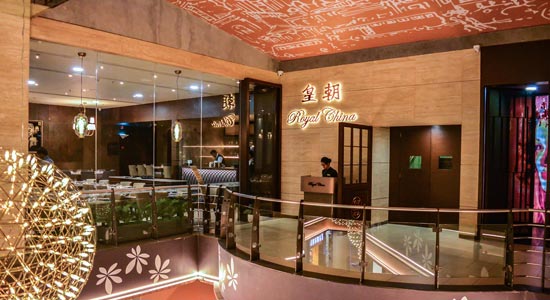
Do you think that going forward customers will be more convenience driven in F&B and it will re-shape the eating order behaviour in the country?
I think fine dining is here to stay and once this pandemic is over, people will be eager to step out and relive the complete dine in experience all over again.
Top learning as a restaurant start-up during the pandemic?
It is difficult and you need to be patient and have deep pockets in order to sustain the current situation.

Owners of McDonald’s west and south in India, Westlife Development Ltd, revenues for Q3FY21 zoomed to 85-90% of pre-COVID levels with December revenues almost back to pre-COVID levels.
Hardcastle Restaurants that owns the franchisee right for the brand is also planning to expand the QSR chain by adding more stores to its network.
Also Read: McDonald's opens outlet at Mumbai-Terminal 2
“The company plans to open three new stores in this quarter and then resume its growth journey of adding 25-40 stores every year from the next fiscal,” shared Amit Jatia, Vice Chairman, Westlife Development.
"Convenience channels are here to stay. For occasional use for the restaurants, where people used to come for hang-outs and celebrate, this was not being met and that need is coming back. It would not take away (business) from the convenience channels," he added.
Westlife Development’s strong sales performance in the quarter was driven by the Ccompany’s omni-channel strategy. It started its recovery journey in October when its biggest market – Maharashtra finally opened up for dine-in.
"The business has gone up month after month. In December, we were almost 97 per cent of the pre-COVID-19 sales. Even Ebitda margin for the month of December was 13.1 per cent, which gave us a lot of hope, as we are moving up month on month. I feel it is here to stay," added Jatia.
In December, despite substantial regulatory restrictions in several of its markets, the Company saw a phenomenal uptake in sales with revenues coming back to 97% pre-COVID levels. Dine-in recovered 75-80%, even with night curfews and the 50% capacity constraint. McCafé recovered over 80% vis a vis pre-COVID levels. At the same time, sales from convenience channels accelerated to 120% of pre-COVID levels in the month, again notwithstanding the night curfews in some of its key markets.
The Company also got back on its growth path and added three new McDonald's restaurants and three new McCafés to its portfolio.
Currently, Westlife Development operates 304 McDonald's stores in 42 cities of the western and southern India.
May Interest: Hardcastle Restaurants opens 300th outlet of McDonalds India
"Around 60-70 per cent of new stores would come in the six key cities - Mumbai, Pune, Ahmedabad, Bengaluru, Chennai and Hyderabad; and the rest 30 per cent into smaller towns," he concluded.

Westlife Development Limited (BSE: 505533) (“WDL”), owner of Hardcastle Restaurants Pvt Ltd (“HRPL”), the Master Franchisee of McDonald’s restaurants in West and South India, announced unaudited financial results for the quarter ended September 30, 2020.
The results were taken on record by the Board of Directors at a meeting held on Nov, 6.
In the quarter under review, the company reported strong sales recovery led by its convenience channels that include delivery, take-out, drive-thru and on-the-go.
Sales through these convenience channels zoomed back to their pre-COVID levels in September, while in-store started showing healthy recovery trend as the Government started unlocking markets in a phased manner.
“I am happy to share that we have effectively steered this crisis and have got the business on a strong recovery track this quarter. Our strong financial foundation combined with a focus on accelerating our omni-channel strategy is reaping great results for us. We look forward to the opportunities that lie ahead and are motivated by the recovery in business that we have seen in this quarter. I am confident that we will soon be back on our growth path,” shared Amit Jatia, Vice-Chairman of Westlife Development Limited.
Also Read: McCafe to be present at every McDonald's India outlet by 2022
As a result, the company more than doubled its overall sales over Q1FY21, achieving close to 70% of pre-COVID levels. This was despite Maharashtra – the state that has close to 50% restaurants of the company - remaining shut for dine-in.
The company saw the pace of recovery across its operations accelerate, with recovery rate progressively increasing by 7-10% every month. Stores that were open for dine-in for more than five months came close to pre-COVID levels, with those that opened up recently recovering twice as fast.
Strategizing for growth
Westlife Development’s strategy for business revival has been focused on three key pillars of Assurance, Convenience and Access. With its ‘Golden Guarantee’ platform, it has made the McDonald’s experience as safe as possible for both its customers and employees. The company’s implementation of contactless operations, heightened sanitization across touch points and new hygiene protocols have helped build back customer confidence in a big way.
The company has also moved quickly to launch a bouquet of convenience services including contactless delivery, digitally-enabled contactless take-out and the innovative on-the-go service that has transformed all its restaurants into digital drive-thrus. These services have ensured that safe, hygienic and delicious McDonald’s food is available for customers whenever, wherever and however they want.
May Interest: McDonald's- North, East partners with DotPe for contactless ordering
Another key lever of strategy has been Access. Identifying the need to offer great value to the customers, Westlife Development has been giving its customers compelling combos and offers through its McDonald’s and McDelivery app. This quarter, the company also tapped into key occasions such as World Chicken Day, Friendship Day and World Photography Day to enhance frequency and give customers more reasons to celebrate with McDonald’s.
With customer confidence slowly building back buoyed by festive cheer and opening up of dine-in services in Maharashtra, the company is confident of accelerating the pace of recovery and marching towards achieving and exceeding pre-COVID level revenues.

What was the whole idea behind Coffee Culture?
The idea behind coffee culture was to create the neighbourhood community spaces that connect with local culture & to serve fresh food with speciality coffee. Coffee Culture was started with an aim to change the way people look at coffee cafes.
We have seen that India got its refined coffee with the entry of global coffee chains. How are you trying to give them a tough competition?
Way back in 2004, when we started our first outlet - there were national and international brands of coffee cafes mushrooming in India. That’s when we realised that Good Coffee Places requires Good Food. So we started Cafes with Live Kitchen & Fresh Ingredient Fusion Food unlike Other Cafes. We are now present in 18 cities & are about 22 outlets pan india.
What is your USP?
Food is our forte and to distort the normal, our nature. You will witness the fascination that we create with our Beverage and Food presentation - distinctive and eye-boggling. Be it serving our burgers in a treasure box or our sizzlers in a wooden ship, or our iconic coffee mug - or fish bowl martini to create theatrics. We create a culture by unlearning what we have been taught. Our sense of design and food presentation will make you flabbergasted. Tugging those norms, we broke the shackles and become unculturally cultured.
We have seen that the best of decisions are made over a cup of coffee. What some of the experience that you provide to these corporate?
Best of the decisions are definitely made over the cup of coffee as we have seen a relationship start at our place and grown into a marriage and now they come with their kids. Nowadays when it comes to corporate environment a lot of deals do happen in an informal atmosphere as u feel better and open up in conversation in such spaces. A lot of corporates or co-working spaces too have realised this opportunity and positive about cafe like spaces so they have to adapt to making the office environment more quirky and cafe like to invite better productivity, openness, culturally stronger teams and better work environments.
How have you designed your cafes keeping in mind your target customers?
We are inconsistent and we are proud of it. Across India, we have different identities and messages that reflect our personality; unique and varied. To Unculture is our culture; to be boldly incoherent is our culture. We have created an ecosystem that empowers our idea to stand out, that challenges the norms that govern the rest. We dare to be different. We dare to take that detour.
We are not just any usual cafe. We fall somewhere between a café and a restaurant. What matters is we can serve you so good, you might forget what you were in for. At CC, we have developed a culture so unique; it’s amazing to see what you can do when you are not tied. We have outdone ourselves by serving live food at our restaufés. Yes, we call ourselves Restaufés. We are changing the face of the eatery ecosystem by being unconventionally conventional.
What is the average footfall at your cafes?
150+ on weekdays & 250+ on weekends per Outlet on an average. 5000+ in a month.
Tell us about your wide variety of menu other than just coffee because a delicious coffee needs right pairing?
We always believed in creating cafes with good and fresh food. On an average a customers spends at least 75 minutes in a cafe and an average cafe when it doesn't serve good food was a great opportunity for us to create a menu with so many favourites.
You are already running 22 outlets across 18 cities. What is your expansion plan?
By 2021, we have an aim to add upto 75 more outlets to reach 100 mark.
Since, you are into franchising. How does one begin in FnB - franchise chain? Why is franchising more beneficial?
A minimum of owning and operation 3 locations, making sure all the systems and processes are in place, the brand is successful in terms of generating enough volumes per store to generate ROI in 18 months, and the brand has the potential to scale into different markets easily; that’s when a brand can franchise post creating the right business model which is easy to replicate, function, invest & get returns. In short making it successful on B2C level and then creating a financial model and build right systems and processes on B2B level. Cafes and Restaurants always require personalised approach. The industry thrives on attention to detail, passionate souls to serve good food and coffee, and we make sure that local owners of each cafe are an asset to the brand and the consumer. We get more and more people to join hands and make sure that everyday operations, experience, and profitability of the outlets are intact. Franchise has always been beneficial in taking our brand to any locations across the country with local knowledge, network and knowhow.
What is the motivation to create Indian culture inspired Cafes? When can we see you compete with our very Indian café CCD?
Cafes have always been places to meet may it be any kind of conversation - a date or friends or family or professionals - everytime people would want to hit at a neighbourhood place - so we believed strongly in creating neighbourhood place in right sense by taking up local elements in our spaces. CCD in terms of offerings and as brand has never been a competition or for that matter any other coffee cafe brand as we have always been an all day dining cafe from inception, so people do prefer us for anytime meals at anytime of the day; which has been our selling point always.

The recent shut down of McDonald’s restaurants in North India has proved to be a boon for other burger restaurants. According to a recent statement shared by Indianised burger chain Burger Singh, the homegrown burger brand has grown up to 36 per cent at most of the outlets located closer to McDonald’s.
The QSR chain has seen an average about 27 per cent increase in the overall sale after the burger giant McDonald’s closed its outlet in North and East India for a revival.
Burger Singh also did aggressive advertising and promotions to draw this growth and new customers.
The company hired a clown like promoter to hand over Burger Singh cards to people around McDonald’s which looked almost similar to the McDonald’s clown.
“This short window (of the stores being closed) was a big opportunity for all the burger players to acquire market share and get new customers to try our product. When the elephant dies, the entire forrest feeds. We just got there first,” shares Rahul Seth, Chief of Staff at Burger Singh.
Burger Singh also did active social media promotions including Instagram and Facebook.
McDonald’s Global earlier this May acquired the ownership from Vikram Bakshi and had announced the closure of the restaurants to come back with a fresh look and menu.
McDonald's and Vikram Bakshi had signed a partnership agreement in 1995 to open outlets of the US food service retailer in northern and eastern India for a 25-year period and formed the joint venture CRPL, with both having 50 per cent stake.
In 2017, McDonald's ended the franchise agreement with CPRL over non-payment of royalties which resulted in a legal battle eventually culminating in an out-of-court settlement earlier this month.
The restaurants were partially reopened in North India by opening around 13 restaurants in Delhi with more customized hospitality, refreshed menu boards, merchandising and packaging.
On the other hand, Burger Singh is the largest chain of homegrown Indian flavour burgers in the QSR category in India, with a strong presence in West & North India with 27 outlets in Delhi NCR, Jaipur, Dehradun, Nagpur and Pune.
The brand has also ventured in the UK with two outlets in London and has emerged as the most popular brand of Indian burgers in the state.
Burger Singh raised over $4 Million in two rounds of pre-seed funding and Series A funding from both strategic & angel investors.

It was in 2003 when Ashish Dev Kapur launched Yo!China in India, the indo-chinese version of the quick service restaurant that ruled the hearts of middle class Indians. Little did he knew then that India would witness an altogether different and more diversified palate when he would expand the brand in over 15 years time. Today, people are no more restricted to noodles; they are trying all kinds of Asian Food starting from Japanese, Korean, Vietnamese, Burmese and Thai. This is not only trending but we are seeing restaurants opening around multiple concepts serving the best of Sushis, Singaporean Roll, Bento Boxes to name a few.
THE BUSINESS MODEL
To start an exclusive Asian food outlet, the investment required is around Rs 18 to 80 lakhs depending on the size (500sqft to 2000sqft). Smaller outlets of about 500sqft are required to focus on deliveries which have become a major business driver in this kind of the concept. Operations costs include Rs 7 lakhs on kitchen equipment, Rs 1.8-10 lakhs on interior designing, Rs 10000- 15000 on licenses, and Rs 7.5 - 20 lakhs on franchise fee.
Monthly earnings may range from Rs 6 lakhs to Rs 15 lakhs, with margins of 18 to 30%. Typical break even time is anywhere between 1-2 years.
Commenting on how the demand for Asian food is consistently growing year-on-year, Aayush Agrawal- Director, Wok Express says, “With rising per capita income and urbanization, Indian’s demand for various superior food products along with the urge for experimentation has led to necessitating a possible change in the food consumption pattern. They are warming up to the mixed bag of cuisines and flavours now available to them like Chinese, Japanese, American, Italian etc.
Adding his view on the same Praful Chandawarkar, Owner, Malaka Spice that was one of the first smart dining concept shares, “Footfalls are now divided and spread due to much larger options now available in the market . Average spend has increased marginally by 5% year on year.”
FRANCHISING FOR BETTER RETURNS
Further, Karan Tanna, CEO, Yellow Tie Hospitality, which runs Wok This Way, a concept where you can make your own wok shares, “There are lot of oriental brands in this space but WOK This Way is unique vegetarian and healthy WOK and Oriental concept in the market. To have the consistency of the product in oriental cuisine, the standardization of sauces is very important.” “In a franchise model, the franchise owner will get standardized sauces recipe from the franchisee and he will be trained to make every dish in a consistent taste every single time. Hence, because of support of consistency and standardization of not only products but also supply chain service level in entire restaurant business. It is very important to prefer franchising option in this space,” he further adds.
Sharing his view on the same, Kapur, who has expanded Yo! China to over 40 outlets, says, “Consumers order more from branded spaces. A franchise of a brand guarantees a certain business.” He looks for Investment Capability, Know-how of the sector, working style-connect with the Franchisor and on background check while signing a franchisee.
WAY FORWARD
Amid several fears over whether delivery will take over these small food concepts, experts believes that a retail convergence is the way forward. “Footfalls come from all sphere from office to corporate crowd from family to friends outings,” shares Saurabh Khanijo who is running Wanchai by Kylin that does a monthly sales of Rs 15-20 Lakhs of a restaurant that lies under 200-300 sqft.
Thus, we can see that with low on investment and high on profit side, Asian food concepts are really scaling in India. Brands like Mamagoto, Asia Kitchen and Mainland China that are on the higher-end targeting a much more experienced customers are also capturing a bigger pie of the franchise market by enrooting to international destinations.

Fast casual industry has changed the restaurant scenario globally. And, we can call it the next wave of limited-service restaurants that might change how India used to dine out entirely in last few years. A fast casual restaurant combines elements of quick-service with casual dining for an experience that is relatively low in cost but often provides ambiance and varieties of food more associated with sit-down dining.
With freshness to the table, customization to one’s preference and a much more personalized experience, fast casual restaurants are here to stay for long.
When Consumer Becomes the Driver
“Consumers are getting more adventurous and open with their palate which is adding to overall eating out culture and driving growth in consumption,” shares Saurabh Khanijo, Director, Welgrow Hotel Concepts, whose restaurant Shophouse by Kylin has got wonderful response in NCR.
As per industry experts, consumers have become much more experimental and adoptive. Karan Tanna, CEO, Yellow Tie Hospitality, says, “Consumers now prefer concepts that are ‘younger and cooler’ and are moving away from mundane fine dining concepts. Consumers not only want good food and service but also prefer some kind of an added advantage and experience; it could be a live music gig or some kind of theatre happening in the plate. That’s why we see popping up of lot of modern fast casual restaurants.”
Business Model
To start a fast casual restaurant, typical investment required is anywhere between 30 lakhs to 85 lakhs depending on the area of the restaurant. Ideally, a fast casual restaurant requires an area of 300-1,000 sq. feet. The startup cost includes expenses of Rs 18 lakhs on kitchen and bar equipment, Rs 3.6 lakhs as interior designer fees, and one-time franchise see may go upto Rs 20 lakhs.
A fast casual restaurant may require 10-18 employees with total salaries ranging from Rs 2 lakhs to Rs 3 lakhs per month. While the rent could take up Rs 3.5 lakh depending upon the location, raw material expenses will be roughly Rs 7 lakhs and Rs 2.25 lakhs go in miscellaneous expenses including electricity and water.
With a monthly revenue of Rs 25-30 lakhs and monthly expenses of about Rs 15 lakh, the owner can make gross profits in the range of Rs 10-15 lakhs. In a typical franchise setup, businesses can break-even in 24 - 30 months.
“Brand awareness is the key factor. We’ve realised that it is all about quality, reasonable pricing and providing a unique experience, which helps in getting good returns,” points Krishna Gupta, Managing Director, 1441 Pizzeria, which has an average footfall of about 4,000 per month with average spending of Rs 450-500 per person.
Why Franchise?
According to most of the industry experts, franchise business is the best way forward in this space. “Restaurant business comes with lot of challenges as far as kitchen operations and training is concerned. Having a franchise partner who can give ready-to-serve recipes (so that dependency on the outlet level staff is reduced) and provides training will make it easier for the owner to operate the outlet. Hence, franchising is best option in this space,” adds Tanna who provides end to end solution to its franchise partners.
Gupta adds, “Starting your own restaurant is not easy and a lot of startups shut within 15 months. We have a tried and tested concept which is evergreen without most of the unpleasantness that comes with starting something new. We have a central kitchen which would supply all the goods and food items and also a training team in the back-end. This is over and above all the manuals for operations, HR, training, food and the customer experience that we provide.”
Future Prospects
As the fast casual concepts are more open to customers where they are aware what is being cooked/baked for them, it automatically becomes more scalable. From concepts like ‘do-it-yourself,’ wherein you can customize and design your own food and decide on what toppings and sauces to be added on your favourite pizza it is becoming a favourite among young crowds who always look for some fun and quirkiness on the menu.
“If the customer likes the food and the complete experience, he visits at least 3 times a month as per our repeat customer ratio,” adds Khanijo who believes that such kind of concept has got a long shelf life and is looking to expand Pan India focusing on metro on the first go.
“We are running 25+ outlets of Genuine Broaster Chicken across pan India and the response has been great. We are looking at opening around 60 more operating outlets in India by the end of this year across segment,” adds Tanna who will be deepening their presence in the locations they are already present. “We are looking at places such as Varanasi, Udaipur, Ludhiana, Chandigarh, Bhopal, Indore, Nagpur, Nashik and Kochi, among others,” he further adds.
And, hence a dining experience where higher-quality ingredients, enhanced hospitality, and cozier dining rooms could mesh with lower prices and counter service, fast casual is the future of restaurant business in India.

Kerrimo is the pioneer in the Philippines in franchising the food and drink in one cup concept i.e., the food and drink are put together in one carry-all cup so that the consumers can enjoy just carrying both in one hand.
The fast-food brand Kerrimo was first introduced in 2007 but it was acquired by our company named Kerrimo Inc, in 2011, and we grew it from there, Armee M. Lanto, International Franchise Marketing Head of Kerrimo tells Restaurant India. In the Philippines, there are more than 100 stores, at present. Through FranGlobal, Kerrimo is looking to establish a good strong franchise network in India.
Venus Barak, CEO, FranGlobal mentions that a brand like Kerrimo will have a huge acceptance in India considering the small store format and easy-to-consume products which could be a great hit at cinemas, metro stations, railway stations, airports and local markets.
In an exclusive interview with Restaurant India, Armee M. Lanto, International Franchise Marketing Head of Kerrimo and Engr. Edmund T. Lanto, President and CEO of Kerrimo speak about the brand’s growth plans in India.
Indian Industry in the Fast Food Segment
The various food options in the market have led to a rise in the demand for newer and sustainable products. “The Indian market is open to international food choices now. India is very rich in its culinary history which we think we can infuse in our concept. We are very excited on how we are being introduced to the Indian food market,” says Armee M. Lanto, International Franchise Marketing Head of Kerrimo.
The Unique Combo Concept
Speaking on whether the unique combo concept will disrupt the fast food segment, Armee says, “Hopefully, in a good way.” “Our concept provides convenience along with the flexibility in serving the combos. Right now, Kerrimo offers french fries, sausages, nuggets but here we will serve items that are familiar to Indian palate - paneer, soya, and biryani,” adds Armee.
With Kerrimo, Armee and Engr Edmund are planning to open a new door of employment opportunities in India. Edmund T. Lanto, President and CEO of Kerrimo, says, “Keeping our core values intact, with our brand, we aim at providing employment, and business development opportunities in the Indian market.”
Expansion Plans in India
“We are starting off with major areas - Delhi-NCR, Mumbai, areas in Maharashtra and Bengaluru - as has been identified with FranGlobal,” says Armee.
She further adds, “We are very happy to see that many franchise applicants are excited to get associated with our brand. In the next five years, we are focusing on not less than 100 outlets pan India. We are very positive in that.”
Competition in the Indian Market
Armee tells Restaurant India that Kerrimo is the only player with such packaging in the industry segment in the country at present. “In terms of packaging, we are the only ones in India. But in terms of food, local fast food and snack joints, as well as bigger fast-food players, are our competitors,” says Armee.
Through its unique packaging, Kerrimo intends to create a new market segment in terms of the combo of food and drink. Armee says, “Indian market is familiar with the French fries and potato products but the way we present the food is something very unique and we hope that Indian market, especially the younger generation will appreciate it.”
The desire to eat healthily is growing and gaining popularity in India. Therefore, with Kerrimo, Armee and Edmund plan to keep the health quotient balanced in food. “Our R&D team is working on developing healthy food products. In drinks, we intend to serve organic and fresh options to cater to the specific market who demand healthier products,” informs Armee.
Franchise Strategy in India
“With the help of FranGlobal, we are looking at developing the area master franchise or area development partners. We have identified the key areas and are looking for the franchise partners for the same. We will put up our own store and recruit more franchisees to develop in that specific area.”
Franchise Selection Criteria
Apart from the basic franchise business experience, Armee says, “We are, specifically, looking for the individuals who have passion and dedication to develop the brand and move to a higher level. We are looking for someone who would take Kerrimo as their own and would put not only their resources but even themselves to the development of the brand.”
Franchise startup Investment
For the unit franchisee, the start-up investment will be between $20,000-25000, affirm Engr. Edmund and Armee.

In 2010, two Southern California chefs, Kelly Mullarney and Dean Simon, had one genius idea: reimagine the American comfort classic Chicken and Waffles as an easy-to-eat, made-to-order sandwich. It started with a recipe for the crunchiest, most delicious fried chicken ever. Then came a perfect, not-too-sweet waffle in place of the usual bun. A whole new restaurant concept was born featuring a fried chicken sandwich like no other. With locations in California, Las Vegas, and South Korea, the global 'fast casual' brand is all set to enter the Indian market this year.
The global chain will enter India with its first outlet in Delhi NCR. Bruxie is a fun-casual concept restaurant. It will be launched in the next quarter in Delhi-NCR before the year ends.
Bruxie will be launched by Salt ‘N’ Blues, the food and beverage arm of Imperia Group. Inderpreet Batra, CEO of Salt ‘N’ Blues, established the brand in 2018 with the faith to develop innovative concept-based feasting outlets to give rich and novel experience to its visitors.

Bruxie Co-Founder Kelly Mullarney
Co-founder Kelly Mullarney first opened Bruxie in Orange County in November 2010 with partner Dean Simon to present a new take on The Sandwich, using a proprietary version of an authentic Belgian Waffle to offer a light, airy, crispy alternative to the traditional sandwich bread.
Kelly’s focus is on building Bruxie as a ‘global waffle domination brand’. Speaking to Restaurant India, Kelly Mullarney tells, “I started a consulting company to help small businesses. It’s been 10 years since I am helping small companies grow. Now I am working to grow Bruxie globally; the idea is to make it a global waffle domination company.”
While speaking about launching Bruxie in the Indian market, Kelly says, “I’m not sure if we chose the Indian market or Indian market chose us; we are happy to be here. From the chef’s perspective, I am very happy to be in the Indian market as the palate seems to appreciate bold flavours which I, personally, enjoy very much.”
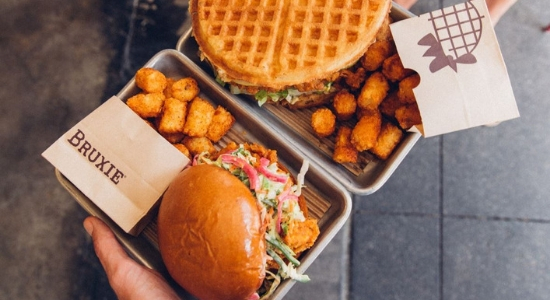
Bruxie will adapt the various aspects of the menu to serve its consumers in India. “We already have certain levels of bold and intense flavour on the menu. We won’t compromise on the core values of the brand – quality and freshness,” tells Kelly.
Also Read: "Finding Right Partners Is The Key To Expand"
CEO of Salt ‘N’ Blues, Inderpreet Batra confirmed the Bruxie flagship store will be 1000-1500 sq feet. “The investment we are doing is around 5 crores for two stores. Currently, there are around 130 waffle stores in Delhi and most of them serve only desserts. Bruxie will be a new concept. We plan to open 10 outlets of Bruxie in next five years. For the first 3-4 stores, our focus is Gurugram, Delhi and Noida. Then we’ll expand to Lucknow, Chandigarh, etc. The franchise is, currently, for the northern region. So, we will be looking for the cities closer to Delhi,” says Inderpreet.

CEO of Salt ‘N’ Blues, Inderpreet Batra
Apart from online promotions and PR activities, Bruxie is also planning to do some in-mail promotions to reach as many people in Delhi NCR. “We want the regular people to know about the concept. We’ll also price the menu items strategically, keeping in mind that consumers come first,” tells Inderpreet.
Bruxie prides itself on culinary innovation in every part of the menu. The most popular item is The Original—a generous, boneless fried chicken breast topped chilli honey and cider slaw, served between two waffle halves. The menu features a variety of other delicious Fried Chicken & Waffle Sandwiches as well as stellar, straight-up Fried Chicken.
Bruxie also serves Waffle-Cut Fries, Wisconsin Frozen Custard and Dessert Waffles.

In 2010, two Southern California chefs, Kelly Mullarney and Dean Simon, had one genius idea: reimagine the American comfort classic Chicken and Waffles as an easy-to-eat, made-to-order sandwich. It started with a recipe for the crunchiest, most delicious fried chicken ever. Then came a perfect, not-too-sweet waffle in place of the usual bun. A whole new restaurant concept was born featuring a fried chicken sandwich like no other. With locations in California, Las Vegas, and South Korea, the global 'fast casual' brand is all set to enter the Indian market this year.
The global chain will enter India with its first outlet in Delhi NCR. Bruxie is a fun-casual concept restaurant. It will be launched in the next quarter in Delhi-NCR before the year ends.
Bruxie will be launched by Salt ‘N’ Blues, the food and beverage arm of Imperia Group. Inderpreet Batra, CEO of Salt ‘N’ Blues, established the brand in 2018 with the faith to develop innovative concept-based feasting outlets to give rich and novel experience to its visitors.

Bruxie Co-Founder Kelly Mullarney
Co-founder Kelly Mullarney first opened Bruxie in Orange County in November 2010 with partner Dean Simon to present a new take on The Sandwich, using a proprietary version of an authentic Belgian Waffle to offer a light, airy, crispy alternative to the traditional sandwich bread.
Kelly’s focus is on building Bruxie as a ‘global waffle domination brand’. Speaking to Restaurant India, Kelly Mullarney tells, “I started a consulting company to help small businesses. It’s been 10 years since I am helping small companies grow. Now I am working to grow Bruxie globally; the idea is to make it a global waffle domination company.”
While speaking about launching Bruxie in the Indian market, Kelly says, “I’m not sure if we chose the Indian market or Indian market chose us; we are happy to be here. From the chef’s perspective, I am very happy to be in the Indian market as the palate seems to appreciate bold flavours which I, personally, enjoy very much.”

Bruxie will adapt the various aspects of the menu to serve its consumers in India. “We already have certain levels of bold and intense flavour on the menu. We won’t compromise on the core values of the brand – quality and freshness,” tells Kelly.
Also Read: "Finding Right Partners Is The Key To Expand"
CEO of Salt ‘N’ Blues, Inderpreet Batra confirmed the Bruxie flagship store will be 1000-1500 sq feet. “The investment we are doing is around 5 crores for two stores. Currently, there are around 130 waffle stores in Delhi and most of them serve only desserts. Bruxie will be a new concept. We plan to open 10 outlets of Bruxie in next five years. For the first 3-4 stores, our focus is Gurugram, Delhi and Noida. Then we’ll expand to Lucknow, Chandigarh, etc. The franchise is, currently, for the northern region. So, we will be looking for the cities closer to Delhi,” says Inderpreet.

CEO of Salt ‘N’ Blues, Inderpreet Batra
Apart from online promotions and PR activities, Bruxie is also planning to do some in-mail promotions to reach as many people in Delhi NCR. “We want the regular people to know about the concept. We’ll also price the menu items strategically, keeping in mind that consumers come first,” tells Inderpreet.
Bruxie prides itself on culinary innovation in every part of the menu. The most popular item is The Original—a generous, boneless fried chicken breast topped chilli honey and cider slaw, served between two waffle halves. The menu features a variety of other delicious Fried Chicken & Waffle Sandwiches as well as stellar, straight-up Fried Chicken.
Bruxie also serves Waffle-Cut Fries, Wisconsin Frozen Custard and Dessert Waffles.

There comes a stage in business where every entrepreneur needs to take a stand whether to expand the business and meet its potential growth. A business can only upscale and grow if the right decisions are taken, at the right time. The entrepreneur needs to ensure that the business operations and sustainability are stable, before they plan the next phase of expansion.
While there are numerous benefits, you can get from the expansion of your business, you need to do thorough research and planning before up scaling. The most essential thing before implementing an expansion plan for your business is to have an adequate bandwidth and funds. In case the expansion does not turn out the way it was planned, towards profitable growth, at least, you have contingency and bandwidth funds as a backup for sustainability of the business.
The business is worthy of doing only when there is an upward growth and brings value and excitement to the entrepreneur and his team members. There are various aspects involved in the successful expansion of the business. Yellow Tie Hospitality has adopted 4 easy steps to upscale their restaurant business using Franchising as a pivotal tool.
Business should be able to add Value: The first point you need to consider for successful business expansion is that the plans for up scaling the business should add value to the business for upward growth. If a business does not add any incremental value and surges excitement for expansion and growth in the entrepreneur, the up scaling efforts are futile. Yellow tie was successfully launched in 2015 and with the major strategies to make a mark in the hospitality industry. It focused on bringing international brands to India, and developed its own brand. It was led by a passionate leader and this growth has brought more than 55 operational outlets in its pipeline.
ALSO READ: Yellow Tie Hospitality Is Changing The Way Restaurant Brands Can Scale & Sustain
Team Effort makes all the difference: The second thing you need to consider for successful expansion is that the core team of the company and the leader needs to be at par with each other in terms of passion and dedication to the business. Business is all about good relations and teamwork with your vendors, suppliers, and team members. The collaboration of teamwork is the most essential for successful business growth and expansion. Yellow Tie Hospitality has truly reflected strong teamwork. The team strength of the Yellow Tie has grown from 3 to 70 in the past three years. Young leaders have taken charge of multiple roles with diversifies responsibilities to implement aggressive growth plans. “The idea to offer entrepreneurs readymade restaurant concept that can be scaled up and managed with ease”, believes Karan Tanna, a 31-year-old Founder and CEO of the Company.
MUST READ: How Training Helps Build A Healthy Restaurant Culture
Going in the right direction: Karan Tanna focused on spending his precious time in the right direction. Be it any kind of business, the entrepreneur focused and dedicated his time to the right aspect of the business for increased efficiency, which set the groundwork for successful expansion. If the entrepreneur does not put up the right efforts at the right places, a business will never grow. The art of delegating responsibilities to the team members, adding the right values to the business and hitting the right chord in every business decision is crucial to achieve sustainability and growth. A hasty decision without proper analysis and discussion with the team members for an expansion of the business can backfire, most of the times.
Business Networking & Building Relationships: When Karan Tanna started Yellow Tie Hospitality, he travelled to various franchises to build friendly relations to expand business. The start-up earned investors by the way of successful testimonials. The company worked hard to ensure that the outlets that partnered with them initially achieved decent returns on their investment. Today, it has an analytical team to manage the PR & Networking at the right forums for the company. It has successfully partnered with 200+ entrepreneurs in just a year and it continues to succeed progressively. YTH has brought the Genuine Boaster Chicken franchise in India in the year 2016 and also partnered with celebrity Chef Harpal Singh Sokhi to start up Dhadoom, Twist Of Tadka & BB Jaan. Managing the logistics and the supply chain was among the toughest challenges that Karan Tanna had to overcome.
MAY INTEREST: How Top Restaurants Are Keeping Design Minimal
With the successful implementation of the business strategies for successful growth and expansion of the business, and sheer hard work and dedication from Tanna and his team has led to YTH success and successful upscale for the value of the brand. YTH has various achievements under its belt in a short span of time. YTH brand 'Dhadoom’ has been awarded India's Top 100 Franchise 2019, 'Wrapchic’ has won Best Debutant Quick Service Restaurant award in 2018, 'Genuine Broaster Chicken’ has been awarded as the Best American Style Diner in 2017. The brand had also won the Best Debutant Chain award in 2016 when it witnessed a whopping revenue of 1 Crore in its very first financial year.
Tanna says that he plans to upscale and expand Yellow Tie Hospitality but he understands that YTH is “limited by our bandwidth”. He also believes that this will soon change and growth is surely on the cards in the near future.

Food Franchise and Restaurant Management company Yellow Tie that run brands like Genuine Broaster Chicken, Wrpachic, Just Falafel, Dhadhoom to name a few started it’s incubation centre in May 2018 & partnered with two brands – Umraan Regional & Wok This Way.
Started by Karan Tanna, Yellow Tie is partnering with brands that are unique and are scalable in its nature. For example; Umraan Regional, a brand that brings together authentic regional recipes from different parts of India. The brand presence has grown by 500% in just 10 months of partnering with Yellow Tie. Similarly, Wok This Way, a healthy vegetarian oriental wok concept has grown exponentially in last 10 months in terms to scaling the business through franchising.
“We are also planning to add five more brands under Yellow Tie Hospitality’s incubation centre in 2019,” shared Tanna who look after certain criteria for taking up brands under their incubation centre. “We focus if the brand has potential of being category leaders & have shown unit level economics,” he further added.
Expanding through Franchising
Umraan Regional launched its first franchise in Oshiwara, Mumbai and has four restaurants coming up in Nagpur, Sonipat, Bangalore & Ranchi. Meanwhile, Wok This Way is opening outlets at Oshiwara, Mumbai followed by outlets in Sonipat, Haryana & Kandivali, Mumbai.
“I am extremely happy to collaborate with Yellow Tie Hospitality as they understand the vision that I have for Umraan which is to take Indian regional food across the world. We are the first movers in Indian regional Food QSR and with this association we can penetrate market faster,” said Rahul Malik, Brand Owner of Umraan Regional.
The brand that runs over 50 restaurants under various category is also planning to add 60 more outlets of various restaurants brands that it operates. It is also eyeing locations such as Varanasi, Udaipur, Ludhiana, Chandigarh, Bhopal, Indore, Nagpur, Nashik and Kochi, among others.
“Wok This Way is India’s first healthy only vegetarian wok concept and we have received tremendous response in our first store. With Yellow Tie we are confident of putting Franchise systems in place and grow nationally and look at International markets by 2020,” added Anand Bhatia, Brand Owner of Wok This Way.
Tanna also acquired Bombay Blue last month from Everstone Capital. The company will also soon launch its new brand 'Yellow Food District' and is entering the food court management segment, especially in greenfield projects and in tier-II and tier-III cities.
“ We are launching the first exclusive Yellow Tie branded food court will in Sonipat in April,” added Tanna who focus a lot on brand building, software, raw material supply, menu engineering, training and marketing.
"Staying true to our vision of giving India’s first soft power restaurant chain and seeing the value we could add to two brands that we have incubated, we have decided to incubate more brands in coming year. We are looking for category leaders brands with proven unit level economics and promoted by passionate restauranteurs," he furhet shared by adding that being India’s first and only scalable restaurant incubator it puts a lot of responsibility on them to increase the rate of success of restaurant chains and make them sustainable. "We want to leverage our experience and infrastructure to make profitable and sustainable brands and there is no more satisfaction than supporting entrepreneurs who have achieved a profitable and differentiator concept," he shared.

Wok-style food has become a global phenomenon as the idea of serving fresh, healthy and customised Chinese/Oriental cuisine option to customers. This option had started globally but was not present in Pune when Riya Shah and her husband Amit Shah left their jobs to start this concept in the city. Excerpts:
Building a Dream Empire
My husband always had a dream of having our own food brand. He has his own real estate business so he could never focus on it. After my first maternity break when I planned to start work again, I thought of chasing my husband's dream of our own food brand. And that's how The Quick Wok was conceptualied. We started with an initial capital of around Rs10-12 lacs.
Targeting people on-the-go
When we started, we didn't target any specific segment. But over time have realised that our consumers are a young, educated audience, both students and working professionals, as well as travelled senior age group people.
Serving a Wide variety
We have regular and mini boxes. The regular starts at Rs200 for Veg and Rs230 for Non veg, while the mini ones start at Rs130 for Veg and Rs160 for Non veg. Apart from quantity, the major difference being that in regular box you can choose more than 12 different Indian and exotic veggies and 4 different garnishes while in a mini box you get to choose from only 5 Indian veggies and 1 garnish.
Why there is a sudden demand in takeout?
I feel the sudden demand in take-out is mainly due to everyone's fast lifestyle today, whether a student or working professional. And, all online delivery platforms have played the role of a catalyst in this. With easy access to smart phones and fast internet connection, everything is at the tip of your finger.
The Rising Love for Asian Flavours
After Indian food, the major demand in India is of Asian food. Since the mid 90's, Asian food has become one of the favourite alternate cuisine for Indians. We just made sure that it was healthy by not using any MSG/Ajino Moto. The ingredients are available everywhere; it's just that you have to choose the right ones. We started with making our own sauces instead of procuring standard canned sauces available in the market. This made sure we knew what was going into the food we are serving. We now have a base kitchen where total of more than 1 ton of various sauces are made every month. We order fresh veggies from the market yard every day. When received, our chef makes sure that the quality of the veggies is up to the mark.
Trend Hitting the Sector
Discounts by online delivery platforms are the biggest trend hitting the industry as of now. Customers are getting so used to discounts that a segment of them won't order if there are no discounts. This has also hit the dine-in business across restaurants.
Expanding the Biz
We have a decent expansion plan over the next few months. We plan to start two more company-owned outlets this year. We are also entering into franchising across Maharashtra soon. This will give us a good spread and visibility.

Suraj Bahirwani realized at an early age that his passion lied in entrepreneurship. At the age of 17, he dived into the world of exports by starting a small venture in the name of Eternal Mark Pvt. Ltd. in Hong Kong. In this humble beginning lied many lessons that he quickly learned and used it to his advantage. His company Eternal Mark Pvt. Ltd. & Emcorp Pvt. Ltd. has now been in business for over 20 years with 100s of satisfied customers worldwide which are from India, East and West Africa, Europe, Russia and the USA.
Suraj has now put his footsteps into the arena of the food and beverage by launching Papparoti in Mumbai with his new company N.K. Hospitality. With years of experience and a knack of understanding of the industry, he feels confident that this venture will echo the success of his other projects.
In an interview with Restaurant India, Suraj Bahirwani, Co-Founder, Papparoti, shares what made him bring the brand concept to India.
Being the Founder of Papparoti

Left to right- Kunal Jethwani , Suraj Bahirwani and Nitin Jethwani (Co-founders of Papparoti)
The first time I bit into the Papparoti bun in Dubai, I always knew that I had a winner and had to bring this to India. It was a lot of hard work and took up a lot of time dealing with Papparoti Malaysia and Dubai, finally getting the brand into India is like a dream come true, but this is only the start though, we have a long way to go.
Papparoti Concept is Different from other Cafes/Kiosks in the Market
Along with our wide variety of coffees and signature teas, we have a unique and delicious bun concept. Our USP is our quality of buns which are exactly the same from Malaysia to Dubai to India and everywhere in the world. Our motto for the buns speaks volumes "every bite different expressions".

Cold Americano with PappaRoti Bun
All 400 plus outlets in the world serve exactly the same buns which are exported out from a kitchen in Malaysia to every cafe around the world.
We are the first players to get the fancy bun concept into India.
Besides, Papparoti is the first cafe to have a strong focus on food. We have an in-house kitchen team that serves freshly-prepared pizzas, pasta sandwiches and more, unlike other cafes who serve ready-to-eat items.
Also Read: How New-Age Bakery Café Is Addressing Millennial
Papparoti’s Competition in the Industry Segment
The F&B sector in India will always have high levels of competition from domestic and international players and when we arrived we were ready for that. Our strength lies in our uniqueness, excellent brand name and a wide range of products.
Home-baked Snack Industry in India

Milk Tea with PappaRoti Bun
India is among the fastest-growing emerging markets. The snack segment in the F&B industry is growing very rapidly in India, at over 20% annually. We are very confident about our product as the bun and chai concept is Indian by heart and, honestly, the consumers really care about is - taste.
In pics: Bon Appétit! 8 Best French Bakery Cafes In Delhi-NCR
Growth and Expansion Plans of Papparoti in Next Two Years
Currently, we have one store in Mumbai, one in Hyderabad and two in Chennai – a total of four stores. We will launch a store in Pune by the 2nd week of March followed by two more stores in Bengaluru in April. We plan to open a few more stores in metros and slowly move to tier 1 and tier 2 cities. We plan to have about 12 stores by the end of the year and about 25 by the end of 2020.
Franchise Partnership Model that Papparoti Currently Follows in India

Black coffee with PappaRoti Bun
Currently, we are following the supply chain model. We charge a fixed franchise fee plus remuneration on sale in return of our brand value, know-how and expertise.
Key Points for a Potential Area Franchise Partner of Papparoti
Main points we consider for a potential franchise partner are Capital Availability, Locations, Passion for the Business and Scalability.
Franchisees Can Miss These Things Due to the Lack of Expertise or Unawareness

Milk Tea with PappaRoti Bun
What franchisees often miss, as they add locations and grow their portfolio, that accounting and reporting for a multi-unit franchise; it is altogether different from the accounting for one business. We often see newer multi-unit franchisees miss opportunities to operate more effectively because they don’t look at each location as a standalone profit centre, with the ability to share management expenses.
Biggest Mistake from the Incoming Franchisees and How To Avoid it
We want to work with new franchisees as a team. The problems a new franchisee might face are something we have already been through. So, a new franchisee should not be afraid to take our help and communicate. Our support, expertise and company resources will be extremely helpful to the franchisee. Secondly, the potential franchisee should learn to walk before he starts to run.

Johnny Rockets boasts a legacy of more than 30 years of irresistible food and infectious fun. The brand believes that everyone deserves a place where they can escape from the complicated world and experience the simple goodness of classic Americana which rings truer today than ever. How? Along with their over-the-top American menu filled with high-quality, craveable classics that put America – and Johnny Rockets – on the culinary map, the brand offers an over-the-top fun experience that no one else does - an escape from the ordinary that engages customers, filled with dancing, ketchup art and uplifting music
FranGlobal has signed Johnny Rockets, the global restaurant brand, for their re-entry in the Indian market. Johnny Rockets features a modern twist on the classic diner - with comfortable seats and areas perfect for gathering, friendly, approachable service and music that combines iconic classics with pop culture.
Founded in 1986, the brand operates more than 350 franchise and corporate locations in 30 countries around the world.

The Johnny Rocket’smodel to success is simple: memories that make people smile in addition to affordable and authentic menus, translating into loyal customers who seek them out, as opposed to the other way around.
In an interview with Restaurant India, Senior Vice President, International Business at Johnny Rockets, Fred Joosten and Vice President, International Marketing at Johnny Rockets, Cathy Kellner-Diaz talk about the re-entry of the international restaurant franchise brand in India.
Reasons Why Johnny Rockets Exited Indian Market
The business was healthy with strong customer awareness and appreciation for our craveable quality food and fun, celebratory atmosphere. However, the franchise partner didn’t have the infrastructure we needed to expand.
Also Read: Finding Right Partners Is The Key To Expand
Target Customers for Johnny Rockets in India
Millennials, who seek authenticity, quality and meaningful experiences, have been a key focus for Johnny Rockets, along with families looking for the same. And while birthdays and celebrations were once a primary reason to visit Johnny Rockets, our appeal has grown to people of all ages looking for over-the-top food and fun in their everyday life - from good report cards to good first dates, from good appetites to - quite simply - good moods.
Competition in the Industry
There are lots of brands offering burgers, but no one offers the lively burger, shakes and fries experience that you can only find at Johnny Rockets.
Main Competitors of Johnny Rockets in the Geographies that it is currently operating in

Hard Rock Café, Chilis, and Carl’s Jr. could be considered as competitors in the region, however, our unique positioning and emphasis on over-the-top Americana and fun truly separate Johnny Rockets from the rest.
Indirect Competition faced by Johnny Rockets
All restaurants face indirect competition from all other restaurants, as well as folks dining at home. Johnny Rockets does not face any more competition in this regard than anybody else, and you can argue they face less due to their unique positioning, flexibility and commitment to the burgeoning off-premise market.
Johnny Rockets’ Marketing Strategies to Counter the Competition Effectively
Our signature experiential elements —DANCING, KETCHUP ART AND STRAW TWIRLS—engage and involve our customers and make us a place to celebrate everyday moments. These are exclusive to Johnny Rockets and make our brand enduring.
Every Johnny Rockets restaurant serves simple, great-tasting food from an innovative menu of all-American favourites including freshly made Burgers, crispy American Fries, classic Sandwiches and indulgent hand-spun Shakes and Malts.
Our all-American concept resonates throughout the world—from Bali to Brazil and Seoul to Santiago—where our brand is thriving with irresistible food and a passion for fun that no one else offers to our scale.
Growth and Expansion Plans in India

We see potential throughout the country in both established and newer markets, especially those with an emerging middle-class and large influx of educated youths including Delhi NCR, Mumbai, Pune, Chennai and Calcutta.
The Franchise Partnership Model That Johnny Rockets Follows, Internationally
Master Franchise, some with sub-franchising ability.
How to Become an Area Franchise Partner for Johnny Rockets
- Available funds
- Operational infrastructure
- Knowledge of his territory and marketing
- Passionate belief in the Brand.

Dubai-based leading French bakery and Restaurant Pascal Tepper is all set to mark its debut in India with World Iconic Brands.
WIB or World Iconic Brands is a specialist franchise development company in India. Five-generation-old brand, it is a modern dine-in bakery and the brainchild of master baker Pascal Tepper who holds the 'Meilleur Ouvrier de France' title, a much-coveted recognition as the best French artesian in the baking trade.
“I have everything to discover from INDIA and INDIA to much to discover French bakery through Pascal Tepper French BAKERY; We have a franchisor and you have a very good future in INDIA do not let it go, work together hand-in-hand and together make Pascal Tepper French Bakery establishments coveted by all INDIANS.”
~Pascal Tepper
In a tête-à-tête with Restaurant India, Siegfried Nierhaus, Managing Partner and Founder of PTG Consulting, talks about the contemporary dine-in bakery concept, and the growth and expansion plans of Pascal Tepper in India.
Pascal Tepper, the French Dine-in Bakery and its Presence Across the World

'Meilleur Ouvrier de France' Pascal Tepper
Pascal Tepper is a contemporary dine-in bakery concept. It is a mixture of best French bakery products and also serves other food and beverages dishes - from starters to retail items. Baker Pascal Tepper is the brand owner; he is recognized by the French President for being one of the best bakers. And that’s why the title 'Meilleur Ouvrier de France'.
Finding Right Partners
We started with Dubai in 2011 with the dine-in bakery. It was a phenomenal success. It is based on quality, consistency, value-for-money and a mix of a nice story which baker Pascal has brought to the fore with the bakery. The idea was to bring the concept out to the world.
We started in the UAE; we have five outlets there. A Pascal Tepper outlet requires an area of 10 to 600 metre per square; it varies. From the food truck concept to a fully-fledged dine-in bakery - we are serving throughout the day from 7 am to midnight. We have catering, dining and takeaways at Pascal Tepper. In UAE, Pascal Tepper is quite successful. After approximately seven years, we think it’s time to roll out the concept globally.

We are considering a lot of countries, but we are expanding with India first. It’s the first time that Meilleur Ouvrier de France is coming to India with his own concept and restaurant.
The Indian market is quite big. India is changing a lot these days because of the travelling possibility Indian community has. The exposure through travels had made Indians more conscious, and, therefore, we see a lot of business coming up in the country’s market.
The key is to find the right experienced partners in different parts of India, who are fulfilling our quality expectations.
I believe there is a big potential for our concept of different sizes in 5 to 7 key cities. The ambitious target is to have opened the first outlets in 2019 and have in total six outlets opened in 2020. A total number of 50 outlets in 10 years is our target.
High Rent Is The Major Challenge in India

A major challenge in India will be the high rents. When you want to position yourself as a top range, as a high-end dine-in bakery, you have to be in a best-possible location. And the best-possible location costs a lot of money.
We are here to make all the stakeholders, the staff and the guests happy. There should be a financial gain to the investors as well.
Our next challenge will be to maintain the quality and consistency in India. We want to produce maximum inside the country and not import the products.
Indian Market for Pascal Tepper
India is always been very intriguing to me – its culture, history, scale and its “Gastronomie” with all the flavours and spices. Every time it is almost like arriving onto a new planet, and while India has always had a culinary influence on the world, its economic and cultural influence is growing. The country represents a large market with consumers who are curious about the world around them, and who are willing to try new concepts and cuisines. So it’s a very promising time to be here. France is a very popular tourist and business destination for Indians so the French cuisine and savoir-faire is not a secret anymore to some Indians. It is time now to bring to India the “Best French Baker” recipes and produce the best possible French bread on site and develop an exciting F&B concept for the ever demanding and growing population.
Pascal Tepper’s Growth Strategy in India

We believe that India has a great potential for our Pascal Tepper French Bakery concept, because of the enormous market and the local production with the available ingredients. If we succeed in this amazing and exciting challenge to develop with our partners a successful Business Model and quality and consistent Food and Beverage outlet, we will be able to develop almost everywhere globally.
Ideally, we should have in every big city our Flagship bakery and restaurant outlet, 3 to 10 smaller bakeries, some Food Kiosks and a Production kitchen.
We could start as well with only the flagship bakery and restaurant where we will produce all our food items and specialities on site.
Marketing Strategy
We want to position our concept as a casual dining Bakery and Restaurant. The Baker products should be the best in the city as we are carrying the best French baker title with us in the brand and the name Pascal Tepper stands for Quality and consistency. Pascal Tepper itself is one of the most “French-looking” bakers with his unique moustache and customer will recognize his face very soon. Our customers will be able to choose from Dine In, catering, delivery or take away and we want to communicate properly on the different ways of receiving Food or beverage items from Pascal Tepper French Bakery.
Money to be Invested?
I think the most important for our brand is to bring the “Know how” of running successfully Food and Beverage outlets, bringing the recipes and savoir-faire of our Menus, the training techniques for the future staff, the brand and its Values to the destination. We will leave the money invested to the professionals and Indians who believe in our brand.

Franchise India's International Arm FranGlobal brings Ice Cream Lab to India. Ice Cream Lab is an innovative International concept originated in California, USA, in 2013. The brand plans to open 100 stores in the next three years and soon will be launching its first outlet in Hyderabad. Ice Cream Lab is known for its innovative way of making made-to-order ice cream right in front of the customers in a minute’s time, using liquid nitrogen. Their freshest ice cream is made of the all-natural ice cream base which is free of additives, preservatives and low sugar.
Introducing Healthy Ice Cream in Indian Market
Vikrant Tomer, Advisory Board Member, says, “As Mark Zuckerberg said, the biggest risk is not taking any risk. In a world that changing really quickly, the only strategy that is guaranteed to fail is not taking risks. Many F&B brands normally get scared to enter the Indian Market due to its vastness, diversity and change of taste over every 2 km. We as Ice Cream Lab, consider it as a great opportunity to come up with a product line which satisfies the taste buds of every customer, yet ensure they are eating healthy ice cream.”
The Ice Cream Lab's idea revolves around the molecular gastronomy freezing concept, using liquid nitrogen to instantly freeze fresh ingredients into ice cream. We fulfil customer’s desires and prepare each cup of ice cream in front of the customer’s eye, it is a very theatrical experience to see the ice cream-making process, where the liquid nitrogen flows into the bowl of organic ice cream base mix and expands in the air, leaving behind the fresh ice cream. The brand offers 16 signature flavours which are universally liked by most of the customers after proper R & D, which takes place time to time and help in developing a product suitable to the local geographies and taste buds of people from that location.
Sachin Pradhan, Operations Director, says “Ice cream is just a perfect thing. People have an emotional response to ice cream; it's more than just food. It’s never heavy or light on your stomach; it is the perfect combination of caring and eating. It helps you to reduce stress; it stimulates your brain and helps to maintain your metabolism.”
“India is full of brilliance, innovation, and creativity and there are plenty of creative ice-cream makers available in India. On the other hand, India has the highest population in the world. This also means that there is still a lot of space for more and more creative makers to introduce more and more innovative brands. We are not here to compete with any brand, as customers are the best judges. They are very clear about their choices and what they want. The molecular gastronomy freezing concept, using liquid nitrogen to instantly freeze all fresh natural cream base using our own secret formula in to the ice cream, it is a theatrical experience to see the ice cream making process, where the liquid nitrogen flows into the bowl of Organic ice cream base mix and expands in air like smoke and evaporates in front of customer's eyes, leaving behind the fresh ice cream,” he added.
Ice Cream Industry in India
Gaurav Marya, Chairman, Franchise India, says, “We are ecstatic to welcome UAE’s Ice Cream Brand in India. Ice Creams have become the modern version of dessert welcomed by all age group of people. On the basis of product, the global ice cream market can be segmented into impulse ice cream, take-home and artisanal ice creams. Furthermore, India is the largest producer of milk, accounts for over 1/5th of global milk production, thereby, offering a large volume of raw material for domestic manufacturing of ice creams. The ice cream market is projected to generate revenue of approximately USD 3.4 billion by 2021. Indian ice cream industry is one of the fastest growing segments of the dairy or food processing industry. Revenue in the Ice Cream segment amounts to US$635m in 2019. The market is expected to grow annually by 11.8% (CAGR 2019-2021).”
Rashed Hareb, the Managing Partner, says, “As a child, my love for ice cream emerged and it has never left me nor it will ever leave me. I am determined to make Ice Cream Lab the most preferred global choice of Ice Cream, loved by people from all walks of life.”
Rashid Alshaali, Partner, says, “A satisfied customer is the best business strategy of all. Any sweet products such as Ice Cream will always remain in demand, People eat Ice Cream when they are sad, when they are stressed and when they want to celebrate and enjoy, its everlasting business.”
Expansion Plan for Ice Cream Lab in India
Venus Barak, CEO, FranGlobal, says, “We have a massive expansion plan for ICL in India. Indian market today is one of the most matured markets in the world that is why a partnership has been formed between FranGlobal and ICL to really bring the best ice cream, best flavours, best quality to Indian Consumers. We already have started building the brand, we will make this product accessible to Indian Consumers by opening stores in Malls, High Streets, Corporate Locations, Airport, Train stations and ICL’s first store will be opening in Hyderabad soon. As exclusive Franchise development and management partners for ICL, we will bring in the efficiency of franchise model in Frozen dessert business to ICL and scale it. This brand is offering a quality shift from Frozen Dessert to the freshest ice cream option, which no other brand is offering.”

Globally, when we look at some of the successful brands, franchising has paved a way for their success story. From opening the first store in early 1990s in India, McDonald’s has taught the Indian market the whole concept of franchising and today home grown brands like Haldiram’s, Bikaneravla and Goli Vada Pav have entered more than 200 plus count in terms of their stores via franchising.
Also, many Indian brands have entered global markets looking at potential targets and catchment and doing great businesses in these markets. “Food and beverages business is not an easy business to make money with. It’s a very tough business to manage. So, anyone who is not experienced and is planning to enter this business needs to partner with people who are experienced,” shared Siegfried Nierhaus , Managing Director, Atlas Hospitality.
Getting the Right Partner
People started food business thinking it is trendy, fascinating but it is very hard to make money. Also, lately we have seen a lot of chefs wanted to take a franchise and they have failed as well, major reason was not the right partner with you in order to develop a successful business model. We are very passionate about food, service and staff but it need to make business sense and you need to calculate properly all your margins. “If you have developed a concept and you strongly believe that you are ready to franchise and you are not making at least 10 per cent NOP in your business for consecutive three years, don’t start franchising,” added Nierhaus.
Also, it is very important to look into the eyes of your partner if things are not going well. Franchise is a large subject. You need technology, product and supply, concept and design everything in place. “If any of you think franchising as a business you need to look at the franchisee and first thing first why somebody needs to invest in your business. As a franchisor you need to make sure that your margins are there and if you expand can your franchise partner make money out of it,” pointed Muhummed Ibrahim, Founder, Chaiiwala.
Commenting on the same, PraveshPandey, Director, BygBrewski Brewing Company said, “The relationship between a franchisor and a franchisee is like a marriage. Either there is bondage or a bonding. A good relationship can be when the partners think about each other. As a franchisor we need to ensure that there is a team which is working on ground with franchisee and always there to help them more as a relationship rather than a checklist or process.”
Hence, we can say that there is no denying that franchising allows restaurant owners and entrepreneurs to experience the freedom of working for themselves while enjoying the safeguards of a successful and establihed business model. But owning a franchise is more than the brand and the blueprint you need to put in equal effort to make the brand even more successful in new geographies and region.

McDonald’s India has posted its first profit during year-to-March 2018 amid a long-drawn legal dispute with one of its key licensee partners.
The global burger giant posted a net profit of Rs 65.2 lakh during FY17-18, compared with a net loss of Rs 305 crore a year ago, according to its latest filings with the Registrar of Companies.
McDonald’s India is operated by two partners in the country; Westlife Development by Jatia’s which is master franchisee for West and South and Connaught Plaza Restaurants (CPRL) that looks after North and East operations of the burger chain.
“The company has not only been able to stem any further erosion of its net worth, but has also been able to successfully reverse the trend of erosion through the infusion of fresh capital,” mentioned McDonald’s India in its latest regulatory filing. Total income which it earned mostly through royalty, grew 8% to Rs 119.6 crore.
During the year, the company allotted shares worth Rs 71 crore to the parent company and also increased authorised capital by Rs 50 crore to Rs 458 crore.
Last week the American burger chain has included the much loved Aloo Tikki burger on their international menu. McDonald’s Chicago is dishing out the humble potato cuttle burger by giving it a vegan tag abroad. This has clearly made a lot of customers happy as many are posting pictures of their vegan meal on Instagram.
The modified McAloo Tikki meal consists of a toasted bun filled with a veggie patty made with potatoes, pea and seasoning reminiscent of samosas. It is then topped with fresh red onions, tomato slices and eggless creamy tomato mayo.
“Customers have expressed interest in items from McDonald’s restaurants located in India and we’re excited to offer them the opportunity to try the longtime vegetarian favourite, McAloo Tikki,” said Nick Karavites, McDonald’s Operator in an official statement.
In the last 2-3 years eating out market has seen a continuous 10% annual growth with QSR segment capturing the bigger pie of the market. Growing urbanization, footfalls at malls where 10-20 per cent spaces are allotted to f&b brands has posted a high growth of these kinds of brands.

A modern Indian bistro, Farzi Café started in 2014 with the aim to bring Indian cuisine back in vogue. The brand has constantly reinvented itself by seamlessly combining culinary art with modern presentations and cooking techniques, showcasing innovative adaptations to offer the finest modern day cuisine to patrons.
The brain child of Zorawar Kalra, the managing director of Massive Restaurants, Farzi Café offers a quirky yet epicurean experience where you enjoy gourmet food , catch up with friends or simply spend some time away from the craziness of your day-to-day lives. “With live gigs and performances by international artists every few months, Farzi Café offers a unique dining experience amalgamates innovative, progressive cuisine with high energy ambience,” Kalra says.

Franchise Overview
Having taken the franchising route in 2015, Farzi Cafe currently operates with five operational and eight under-fitouts. The plan is to open 20 new franchisees in the next 12 months. Under the Massive Restaurants’ banner, Farzi Café is also aiming to introduce top food and beverage brands in the world in the next five years’ time by establishing a brand presence in all the major cities of the world. “We plan to achieve it by opening a large number of franchisee stores in Tier II cities India and around the world, apart from the company-owned restaurants,” adds Kalra.

Franchise Facts
- Total outlets: 11
- Investment: Rs 4 - 6 crores
- Area: 3,500 sq. feet
- Expected return on investment: 30%
- Expected breakeven: 18 - 24 months.

Juice Lounge’ was incepted in 2005 to capture the idea and sell unique juices, power juices, energy boosters and super boosters. The health café has now expanded its presence to 30+ cities in India and abroad catering to the new age customers.
The future plans in regards to India expansion are to penetrate the Tier I, II & III cities that has the market potential. “Our business has a lot of potential as everyone is becoming more health centric. Through this business we can make a healthier India,” shares Manav shital, Director, Black Orchids Pvt Ltd that owns Juice Lounge outlets. The investment is also quite reasonable for a kiosk or an OTC.

Franchise Network
Juice Lounge is currently running 30+ health cafes in India and abroad in cities like Mumbai, Bengaluru, Delhi, Haldwani, Pathankot, Haridwar, Mohali to name a few. “In the next 5 years, we are looking at around opening more than 100+ stores spread across India & other countries around the world,” adds Manav elaborating that evaluating the proposal we choose the route of franchising as it would help the brand to grow faster. The returns for the investment were very lucrative which helps us to grow even faster. The group has also customized the concept as per the taste and likeness of the locals. And, is running in Kiosk, OTC and Lounge Model.
FRANCHISE FACTS
Year of establishment: 2005
Year to start franchising: 2009
Total No. of stores: 30+ (India and Abroad)
Break up of company-owned + franchise stores: 2 (Company owned) & 28+ franchise
Investment required:10 to 18 Lacs depend on the model
Area required (in sqft): 100 to 800 sq feet
Expected RoI:40 to 60% pa
Expected break-even:18 to 24 months
Preferred cities &location: Tier I, II & III cities. High Street & Mall Food Courts are more preferred.

Started in 2015, The Belgian Waffle has disrupted the waffle market in India in last three years. Started off with a small outlet in Mumbai at INOX cinema in 2015, today, the group is running 170+ stores across 40+ cities in India. The Belgian Waffles sells around 20,000+ waffles everyday and has also expanded its presence to neighbouring country Nepal.
“We’ve spent a lot of time getting our product and proprietary eggless batter right, which was really appreciated in terms of quality and consistency,” shares Shrey Aggarwal, Founder, The Belgian Waffle Co that has created a warm, fun and approachable brand identity that resonated with all ages from 8 to 80.
Franchise Network
“The largest QSR player in India is Dominos with ~1300 outlets. We currently have 170+ outlets so it is a long road ahead,” adds Aggarwal who believes that India itself promises to be a very fertile and interesting landscape for the brand and product.
Further, although the brand is amongst the largest home grown QSR chains in India, they harbour aspiration of taking India to the world. “We have established our presence in Nepal and are actively looking at neighbouring countries. We have a product of global standards and this category is well received across international borders. With that in mind we are not aggressively looking at international expansion,” adds Aggarwal.
The brand is also looking at expanding into newer verticals which will help them in leveraging on their pan India brand presence. The idea is to delight the end consumers in categories where there are gaps. “We are also looking some interesting brand partnerships and alliances where we can capitalize on our product and process expertise coupled with the technology expertise of some players to come up with products which will delight the end consumer,” concludes Aggarwal.
FRANCHISE FACTS
Year of establishment: 2015
Year to start franchising: 2015
Total No. of stores:170
Investment required:Rs. 25 – 27 lacs
Area required (in sqft):200 – 300 sqft
Expected RoI:6 to 18 months
Preferred cities &location: Tier II, III cities

It all started with one cook, Colonel Harland Sanders, who created a finger lickin’ good recipe more than 75 years ago, with a list of secret herbs and spices scratched out on the back of his kitchen door. Today his formula for success is still followed in more than 20,000 restaurants in over 125 countries and territories around the world. KFC introduced its craveable chicken to India in 1995 and today has a presence across the country with more than 350 restaurants.
The quarter ending June marked the seventh consecutive quarter of positive System Sales Growth in the country for KFC. “We are currently 350+ restaurants strong and are confident of growing our presence further. Our vision going forward is to continue building on our strengths and delight consumers with the best experience – whether it is taste, service, quality or accessibility,” shared Samir Menon, MD, KFC India.
Franchise Network
The group is actively franchising since 2002, and has reorganized the KFC business under larger, well-capitalized franchisees in 2015 to further boost India growth and create significant value for all stakeholders. “We're in play with both equity and well-capitalized franchisees, and these are the twin engines that drive our growth,” added Menon who belives that their partners are experienced business entities with outstanding reputation to leverage the huge opportunity that India has to offer and, in the process, create significant value for all stakeholders.
FRANCHISE FACTS
- Year of establishment: 1995
- Year to start franchising: Actively since 2002
- Total No. of stores: 350+
- Break up of company-owned + franchise stores: NA
- Investment required: NA
- Area required (in sq ft): 2000
- Expected RoI: NA
- Expected break-even: NA
- Preferred cities & location: Metros and emerging cities

Established in 1982 in Brisbane Aromas Café is one of the first coffee houses to establish a reputation for lounge, ambience, stylish service and great coffee with freshly made food accompanied with liquor. With classic, plush interiors coupled with memorable espresso and signature desserts, the Aromas Café experience is second to none. It was in early 2008 that the owners at Ideal Hospitality India got lured by this café and after a constant research for over a year the promoter Anuya Mhaiskar opened the first café in India. Excerpts from the interview:
How it all began?
We have done extensive research on trends and gaps in the market before finalizing the agreement with Aromas Café (Australia) to introduce the chain to India. The café sector (in India) has experienced substantial growth over the past few years with several more local and international chains joining the competition for market dominance. The true espresso houses however, continue to thrive and be that preferred option; offering character, quality and a perfect setting to catch up with friends, colleagues or family.
Is it a master franchise deal or a joint venture?
We do have single franchise outlet in Mumbai. However, we are yet to expand in other cities and it will be a master franchise deal for all other cities except Mumbai.
We see that globally 90 per cent of the restaurant brands are franchised. Why franchise as a model?
That’s true! Giving franchise is win-win for both the brand & franchise owners. Also, it takes years of experience to create a brand. By taking franchise, we don’t just sell the brand but we do share our experience along with it. Franchise owner are equipped with all tools to run a smooth business & grow as a partners. In return, brand gets faster expansion & presence. By giving master franchise, brand gets city wise owners which help in monitoring the business.
Aromas Café is known for its finest coffee in the Australian market. How are you staying true to its core product value?
We actively look to employee professional and well-presented staff, with an interest in the coffee industry and most importantly bringing a positive personality to the team. Our Baristas are trained by the Master Barista with live Skype feeds from the Australian Master Barista, allowing them exposure to international standards and providing insight into the origins of our signature award winning coffee blend and what it takes to make a perfect cup of coffee.
Food, contributes 65% of the revenue. So it is imperative that the kitchen team is trained by our experienced culinary leadership and our service team by our dedicated training Department. In addition to the ongoing IHPL training course program, the staff is given specialized training to ensure that they are equipped with sound food & beverage knowledge as well as industry best practice bench marks. They are encouraged to continuously work on their skills.
How much have you Indianised the menu keeping the local taste and preferences in mind?
60% of our menu is Indiniased to ensure we don’t loose on the larger target customers in India.
Who are your regular customers?
Coffee culture is spreading tremendously in our country. Mostly Residential & Corporates are our regular clientele. We see our loyal guest for all three time meals at all our outlets.
What is the average footfall at your cafes?
We cater to 1400 - 1500 people daily (for 7 outlets).
We see that all day dining as a trend is picking in India. Why did you choose to be a whole day dining place instead of café as your core service?
We started this trend and then others followed us. Being just a cafe will not satisfy us as we want to cater to all kind of guests. It should be one stop place when it comes to food, coffee with pair of wine & beer.
What is your plan expanding the brand (no. of outlets, cities in target)?
We believe in taking one step at a time. Hence, once we launch an outlet, we make sure that the operations are running smoothly and if ensured about so, we move on to planning the next outlet. We are about to reach a total number of 10 outlets in Mumbai soon. We are looking at expanding to tier 1 and tier 2 cities like Delhi, Bengaluru, Goa, Gujarat and a few more. India is a country of coffee lovers and we hope to take the brand on a Pan-India level, serving the entire nation heartily.
What according to you would be the top trend ruling 2019?
Innovation will be the trend in both coffee & food industry. Earlier, it was about eating & drinking, however now along with the taste, people focus on presentation of the dish. Hence unique and efficient plating and service for dishes and beverages is going to be the top ruling trend in 2019.

With quick returns and profitable business ideas, food franchising has always tempted great investments in India. And, today it contributes 28 per cent to Indian franchise industry ahead to world which is an average of 22 per cent of $3.95 trillion global market place of franchise industry.
Franchising these days is not limited to QSR and casual dining restaurants but fine dining spaces are also eyeing franchising as an option to expand their concept. In addition, today several leading global franchise companies, such as Dominos, McDonald's, Yum Brands, Baskin Robbins and Subway, have already established a presence in India. Franchise industry is expected to benefit greatly from government support across various sectors through various measures including foreign direct investments (FDI) in single multi-brand retail.
With restaurant franchising gaining momentum and finances coming from all corners of the globe, the industry can expect a hefty growth of industry in coming years. According to a report by Francorp, “The Indian franchise industry is expected to grow 30 per cent on yearly basis. The figures of total franchising industry is believed to have reached $ 24bn and focused to touch the $ 35bn mark by 2020.”
Here are five main reasons why franchising is attractive to maximum people:
Asset Light–A franchisee model is asset light and help brands focus more on the product and its quality. Hence, it is a good business to invest in.
Scalable – The model is highly scalable as brands are banking on expertise of product and process and letting the franchisee manage the store operations.
Local Area Knowledge - The key to success in the QSR business is to get the location right. For this local area expertise is of paramount importance and which is what the franchisee partner brings to the table
Focus on Product and Process – This model helps restaurants to channelize their energies on the core aspects of the QSR business - product development & process innovation. Consumer experiences revolve around the product and franchisee experience revolves more around the process.
Branding, Marketing and Distribution– Restaurants have taken cues from several global food brands and have studied their success and business model of expansion. They harbor similar global aspirations and hence want to channelize their energies on product development, branding, marketing and process innovation to rapidly scale in India and overseas.

Juice Lounge’ was incepted on 2005 to capture the idea and sell unique juices, power juices, energy boosters and super boosters. The health café has now expanded its presence to 30+ cities in India and abroad catering to the new age customers.
The future plans in regards to India expansion are to penetrate the Tier I, II & III cities that has the market potential. “Our business has a lot of potential as everyone is becoming more health centric. Through this business we can make a healthier India,” shares Manav shital, Director, Black Orchids Pvt Ltd that owns Juice Lounge outlets. The investment is also quite reasonable for a kiosk or an OTC.
Franchise Network
Juice Lounge is currently running 30+ health cafes in India and abroad in cities like Mumbai, Bengaluru, Delhi, Haldwani, Pathankot, Haridwar, Mohali to name a few. “In the next 5 years, we are looking at around opening more than 100+ stores spread across India & other countries around the world,” adds Manav elaborating that evaluating the proposal we choose the route of franchising as it would help the brand to grow faster. The returns for the investment were very lucrative which helps us to grow even faster. The group has also customized the concept as per the taste and likeness of the locals. And, is running in Kiosk, OTC and Lounge Model.
FRANCHISE FACTS
Year of establishment: 2005
Year to start franchising: 2009
Total No. of stores: 30+ (India and Abroad)
Break up of company-owned + franchise stores: 2 (Company owned) & 28+ franchise
Investment required:10 to 18 Lacs depend on the model
Area required (in sqft): 100 to 800 sq feet
Expected RoI:40 to 60% pa
Expected break-even:18 to 24 months
Preferred cities &location: Tier I, II & III cities. High Street & Mall Food Courts are more preferred.

Having established first Store in Chandni Chowk , Delhi , Bikanervala started spreading its wings and gradually covered Delhi and NCR and their after other parts of the country and it did not stop but crossed the borders and penetrated into neighboring country Nepal to far of countries like USA, New Zealand, Dubai, and Singapore.
With one vision in mind, which resulted into a revolution of serving the humanity with great Indian Traditional taste and takes it across the Globe, Bikanervala is running 80 restaurants globally. While promoting India and Indian heritage, culture and cuisine, making it International class by innovations so as to satisfy the felt need of the entire world by serving good quality delicious and nutritious food.
Franchise Network
Bikanervala is currently running 15 franchise stores globally. “Reliability, Quality, consistency in flavor and economic are some of the important features of the products and products make a brand. This has been our secret to success in Brand BuildingHundred years of experience pooled and presented to the market with customer centric approach,” shares the spokesperson.
FRANCHISE FACTS
Year of establishment:1988
Year to start franchising : 1992
Total No. of stores: 80
Breakup of company-owned + franchise stores: 65+15
Investment required: Approx. 4-5 crores per store
Area required (in sq ft):10,000 sq ft.
Expected RoI: 10-12%
Expected break-even:0.5 Cr Sales PM
Preferred cities &location: India plus Overseas.

Started in 2017, Dhadoom is one-of-a-kind restaurant serving Global Fusion Street Food. Dhadoom offers an exciting mix of international recipes fused with Indian flavours, thus appealing to the Indian palettes of all age groups. “From our Restaurant interiors to our menu, every element represents the vibrant and quirky energy that defines Dhadoom,” shares Karan Tanna, Founder & CEO, Yellow Tie Hospitality that owns Dhadoom.

Dhadoom is eyeing metro cities, Tier II and Tier III cities through a franchise model opening around 50 outlets by December 2019. “I see myself spearheading a revolution in the restaurant chain industry. I will have played a pivotal role in taking Indian home-grown brands across India and the globe. I will be the ‘go- to person’ for any entrepreneur who has started a restaurant and dreams of scaling it up. I will work with many entrepreneurs and early-stage companies and share my experiences and learning that can help them make their brand the next McDonalds or Starbucks,” added Tanna.

Franchise Network
Dhadoom is currently running 14 franchise stores in cities like Mumbai, Bengaluru, Delhi, Mysore, Kolkata and Ahmedabad with 100% franchise stores. “Globally & historically big brands like Mc Donald’s, KFC, Dominos etc. have only grown through franchising that made me believe that if our franchise management capability in the restaurant industry were sharpened we could give a national brand and we could take Indian brands around the globe,” adds Tanna.
FRANCHISE FACTS
Year of establishment: Dhadoom was established in the year2017
Year to start franchising: Dhadoom started franchising in the year2017
Total No. of stores: 14
Break up of company-owned + franchise stores: All are franchise stores
Investment required:15 – 30Lakhs (Depending on Format)
Area required (in sq. ft):100 – 500 Sq. ft.
Expected ROI:15 – 18 Months
Expected break-even:12 – 15 Months
Preferred cities &location: Metro cities, Tier 2 &3

FOOD INDUSTRY is no doubt booming at a fast rate, giving due credits to the rising disposable income of the middle class. Speaking specifically about the Quick Service Restaurants (QSRs) like Pizza Hut, Burger King, McDonald’s, Burger Singh, etc that is growing exponentially in the recent times. According to a last year report by KPMG in association with FICCI on ‘India’s food service industry: Growth Recipe’, the food service industry in India can broadly be classified into four major segments, wherein Full-service Restaurants and Quick Service Restaurants (QSRs) together account for around 73 percent, rest 14.6 percent being street kiosk desks and remaining 12.5 percent being bars and cafes.
Two mega metros, Mumbai and Delhi NCR contribute to 22 percent of the overall Food Services market (11 percent each) followed by six mini metros comprising of 20 percent share in the Food Services market basis the FICCI report on Indian Food Services.“As more and more chains mushroom across multiple regions and franchising being seen as a viable option by a larger segment of the population, the QSR segment has seen considerable changes in the past one year,” says M. Yeshwanth Nag, Founder of The ThickShake Factory.
According to Nag, QSRs are what the modern Indian prefers, as life gets faster and time more precious, consumers need their product created and supplied faster with articulate presentation and perfect taste. “We can see QSRs moving to tier 2 or tier 3 cities more and more in the next few months as more and more players realise the potential for these areas,” he adds.
Urbanisation,youth spending, nuclear families and improved logistics can be a major catalyst to penetrate QSR segment in various parts of India. Also, about 50 percent of India’s population tends to eat out frequently which brings India to a very close proximity to developed QSR spaces across the globe. “Technology will surely play a major role and will be able to cater to different customer segments and help in knowing their taste and preferences. The CRM will be more well defined and will help us tapping new customers along with allowing us to bring back our old customers by giving lucrative discounts and promotions as well,” feels Nitika Kapur, CEO of Nukkadwala about the future potentials in QSR segment.
One of a very interesting trend in QSR segment noticed by Kapur is the shift of serving Indian authentic regional delicacies drifting away from serving western cuisine. The need for the hour is for the suppliers and QSRs to innovate together. To make the business models work, a good balance between the right prices, acceptable transactions on a weekly basis and most importantly ensuring a right supply chain is crucial.
Seeing the potential in Indian market, the traffic to enter the Indian market has increased. "The QSR segment is one of the most exciting segments in the F&B industry today. People are opting for quick, casual and value for money meals and QSRs offer exactly that. For our Japanese QSR we have experienced over 200 percent growth in the last two years,” said Hakuei Kosato the founder and Managing Director of Sushi and More India Pvt Ltd. The company announced their plans to open more Sushi kitchens and also launched their new QSR brand “The Don” in Mumbai recently.With the big brands building up, the small brands are also expected to rocket their operations and sales in the next few years to provide their share in the growth spectrum of the whole QSR segment.

Franchise India's International Arm FranGlobal brings Canada’s most popular brand ‘Dipsidoo’ in India. Dipsidoo is a Dessert Café servingrich and tasty delectable cuisine like Super Milkshakes, Cloud Cones, Churros, Crepes, sundae, funnel cakes, smoothies, bubble waffle sticks Pops accompanied with Frozen Yogurt that adds for a unique signature treat.
FranGlobal, which has the master franchise right for the brand in India plans to launch 250 outlets PAN India in three major store modes like Sit in Large Store Model, Express Store and Kiosk Model.
Tariq Ahmed, CEO, Dipsidoo said, “After successfully catering delightful experience to the customers in North America, we are very elated to bring our unique taste of innovative Dessert Bar tolocal epicureans. Our menu ranges from mouthwatering assortments of Super Milkshakes, Cloud Cones, Churros, Crepes, Unicorn Sundae, Funnel Cakes, Smoothies, Bubble Waffle Sticks Pops accompanied with our Frozen Yogurtand other cool drinks. The food industry in India has been thriving in the current times, owing to the increasing disposable earnings of the middle class, growing young population, working women and their chaotic schedules. Evolution in Food and Beverage industry in India will provide great business expansion for our brand.”
Venus Barak, CEO, FranGlobal said,“We are ecstatic to welcome this exciting new venture – Dipsidoo in India. The market value is estimated to gradually increase through the years, reaching about over 40 billion Indian rupees in 2020. There is a pool of opportunities to delve into for elevating food & beverage business and staying on top with changing customer needs. Today’s consumer looks for relevance in a brand and is highly conscious buyers and dessert is considered to be the hottest and the most attractive snack. We plan to launch 250 outlets at PAN India level in three major store modes like Sit in Large Store Model, Express Store and Kiosk Model. We are looking for a total investment of 200 to 250 Crores in the next 10 years.The foray of Indian restaurants into a variety of global cuisines is having a positive impact on the F&B sector. Customers are more willing to experiment with different cuisines because it is now easily accessible in the cities they live in, and this trend could also increase Indian consumers’ frequency of eating out.”
Gaurav Marya, Chairman, Franchise India said, “We are happy to welcome Canada’s favorite brand ‘Dipsidoo’ in India. The Indian Food and Beverage (F&B) service Industry is one of the most vibrant industries that has seen unprecedented growth in the recent past and continues to expand rapidly.This has attributed to the changing demographics, upsurge in disposable incomes, urbanisation and growth of organised retail. The F&B sector has evolved over the past decade, giving rise to exciting new concepts in food and beverage offerings and new and innovative service elements.Consumers are now spending as high as 51% of their income on food products. Consumers are opting for healthy options at the supermarket as well. The foray of Indian restaurants into a variety of global cuisines is having a positive impact on the F&B sector”

LET’S POPCORN, a Gourmet Popcorn brand is entering India with Franchise India’s International Arm FranGlobal.
LET’s POPCORN which is already present in Qatar, Oman, KSA and other middle eastern company is planning to unplug about 200 stores in the next 3 years in India.
“We are delighted to enter Indian Food & Beverage Market. India has this spurting potential in terms of food and retail. Increasing disposable income and appetite for healthy snacking option, eating culture, and younger population are the key drivers for the market. This gives us a lot of confidence to enter Indian Gourmet Popcorn market,” shared Fadi Faour, General Manager – LET’S POPCORN.
Headquartered in the state of Kuwait it is the first Gourmet Popcorn brand in Middle East, with 65+ exclusive flavours and highest quality ingredients. Each batch is a masterpiece of creation and filled with care. All flavours are air-popped (Oil- Free) which maintains the maximum nutritional value to tantalize the customer’s taste buds in a cosy home like ambience.
Commenting on the association, Venus Barak, CEO, FranGlobal said, “We are ecstatic to welcome this exciting new venture-LET’S POPCORN-in India. The gourmet popcorn business is expected to grow at 36% CAGR.There’s a pool of opportunities to delve into for elevating food and beverage businesses and staying on top with changing customer needs, today’s consumer looks for relevance in a brand and are highly conscious buyers andPopcorn is considered to be the hottest and the healthiest snack.
Also, this is quite exciting for food lovers who also wish to stay in shape and can enjoy popcorns in a plethora of flavours.
“Our expansion target is to open around 200 Point of Sales in the coming 3 years.” The gourmet popcorn segment is still niche due to less geographical penetration, hence offers an immense opportunity to tap this potential in this growing market,” added Faour.
There is no denying that healthy snack business has grown double digit in India in last two years and Asia pacific region has the second highest sales which is 895 million USD.
Copyright © 2009 - 2025 Restaurant India.






